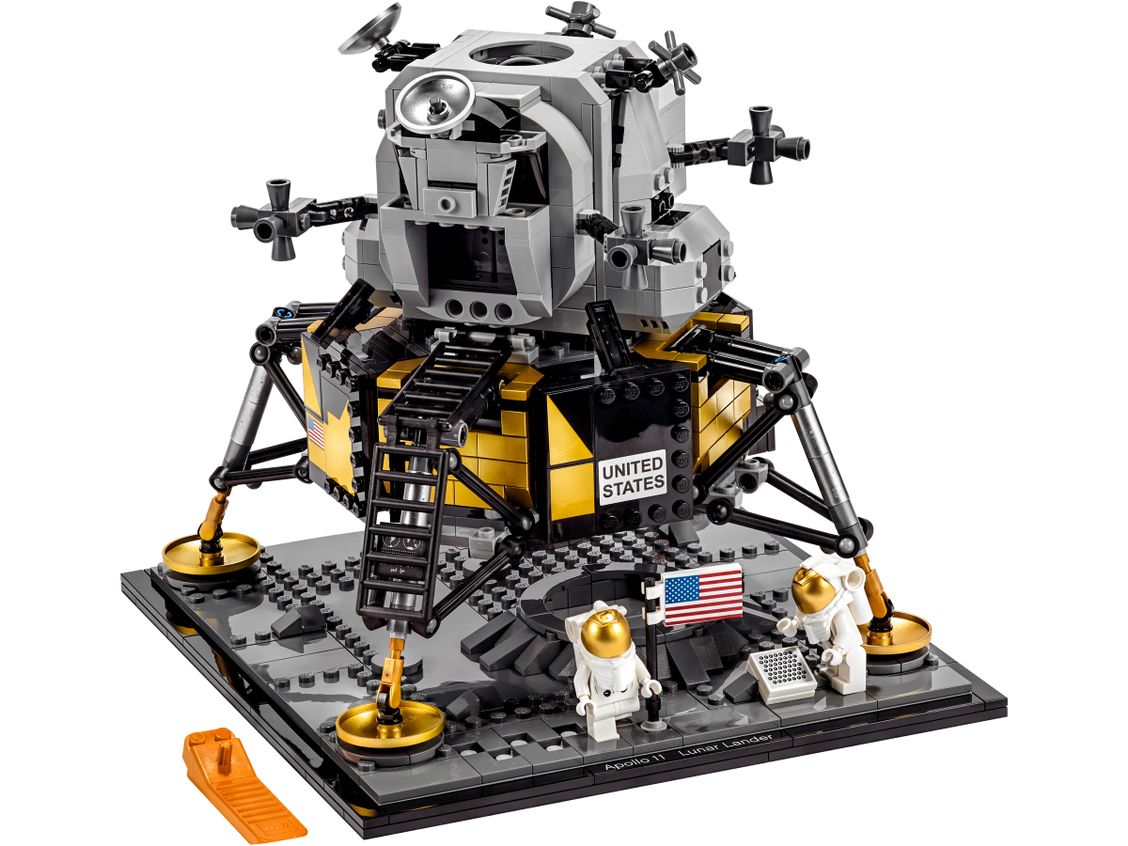Hosts:
Fraser Cain (universetoday.com / @fcain)
Dr. Kimberly Cartier (KimberlyCartier.org / @AstroKimCartier )
Dr. Morgan Rehnberg (MorganRehnberg.com / @MorganRehnberg & ChartYourWorld.org)
Dr. Brian Koberlein (briankoberlein.com / @BrianKoberlein)
LEGO’s New Apollo 11 Lunar Lander has been Released
The 50th anniversary of You-Know-What is coming up and LEGO is getting in on the celebration. The much-beloved company has released a replica of the Apollo 11 Eagle Lunar Lander. The new lander is part of LEGO’s Creator Expert collection.
LEGO teamed up with NASA on this effort, and the model boasts quite a few realistic touches.
Continue reading “LEGO’s New Apollo 11 Lunar Lander has been Released”In Preparation for its Inaugural Launch, the Falcon Heavy Receives its Special Cargo – Musk’s Tesla Roadster!
After years of preparation, SpaceX is gearing up for the inaugural launch of its Falcon Heavy rocket. As the name would suggest, this rocket is the heaviest launch vehicle in the SpaceX arsenal. With a payload capacity of 54 metric tons (119,000 lbs), it can lift over twice as much weight of the next heaviest launch vehicle (the ULA’s Delta IV Heavy). And in time, SpaceX hopes to use this rocket to send astronauts into orbit, to the Moon, and on to Mars.
Basically, the Falcon Heavy is integral to SpaceX’s mission to usher in an age of affordable space travel and restoring domestic launch capability to the United States. With the inaugural launch scheduled to take place no earlier than January of 2018, the company is currently putting the final touches on the rocket. This includes releasing pictures of the payload which will be sent into space, which is none other than Elon Musk’s own cherry-red Tesla Roadster.
The inaugural launch will take place at SpaceX’s Launch Complex 39A, which is located at the Kennedy Space Center in Florida. This same launch pad was where the historic Apollo 11 mission launched from on July 16th, 1969, sending the first astronauts to the Moon. After it launches, the rocket will send send a payload into a heliocentric solar orbit, which will put it at a distance that is about the same as Mars’ distance from the Sun.
In addition, the company will use this inaugural launch to attempt a landing of all three of the Falcon 9 engine cores, which make up the first stage of the Falcon Heavy. In the past, the company has demonstrated its ability to successfully land the first stages of Falcon 9 rockets on land and at sea. However, this will be the first time that multiple cores are recovered from a single launch.
It will also demonstrate that SpaceX is capable of reusing all stages of a heavy launch, bringing it a step closer to fulfilling its promise to reduce costs by developing fully-reusable rockets. Two of the rocket cores will land at Cape Canaveral Air Force Station while the third will land on SpaceX’s drone ship (Of Course I Still Love You) out in the Atlantic Ocean.
NASA is also offering offering viewing opportunities of the launch to the public at the Kennedy Space Center Visitor Complex. In the past, Musk has proposed sending some truly odd things into space, including a wheel of cheese. On December 1st of this year, Musk tweeted that for this momentous occasion, the special cargo would be one of his very own electric cars. As he posted on Twitter:
Payload will be my midnight cherry Tesla Roadster playing Space Oddity. Destination is Mars orbit. Will be in deep space for a billion years or so if it doesn’t blow up on ascent.
— Elon Musk (@elonmusk) December 2, 2017
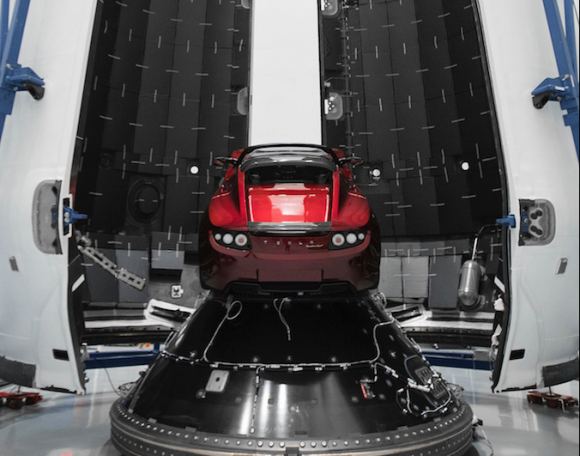
Last week, SpaceX released photos of the Tesla Roadster being loaded aboard the rocket’s payload fairing. Forthe purposes of launching it into space, the Roadster has been mounted on a special adapter structure, which are typically used when launching satellites into orbit. The photos also showed the Roadster being enclosed inside the rocket’s payload fairing, which will carry the car into space and place it at its heliocentric orbit.
Musk naturally avoided making any predictions about the launch, saying only that the launch was “Guaranteed to be exciting, one way or another.” However, when asked about his choice of cargo, Musk was both candid and cheeky in his response, tweeting:
“I love the thought of a car drifting apparently endlessly through space and perhaps being discovered by an alien race millions of years in the future.”
One can only imagine what they will conclude about humans. Perhaps that they were are both environmentally friendly and pretty flashy! While the exact date of the launch is still yet to be determined, Musk is certainly correct in predicting that it will be an exciting event. Given the sheer significance of this flight, the eyes of the world will be firmly fixed on Launch Complex 39A when it does take place.
Good luck SpaceX! And good luck to you too little Roadster!
Further Reading: Kennedy Space Center, Spaceflight Now, SpaceX
Settle the Moon Before Mars, Says Astronaut Chris Hadfield
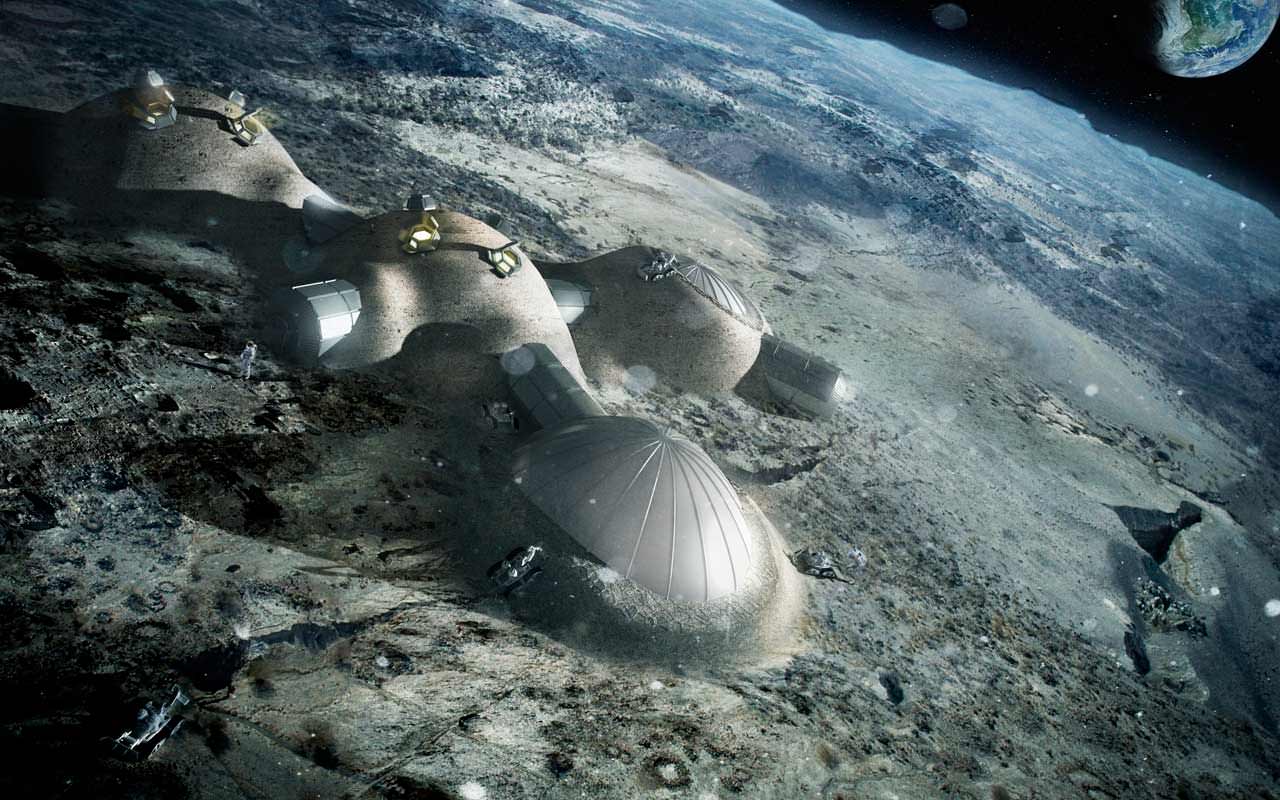
In the coming decades, NASA has some rather bold plans for space exploration. By the 2030s, they hope to mount their “Journey to Mars“. a crewed mission that will see astronauts traveling beyond Earth for the first time since the Apollo era. At the same time, private companies and organizations like SpaceX and MarsOne are hoping to start colonizing Mars within a decade or so.
According to Chris Hadfield, these mission concepts are all fine and good. But as he explained in a recent interview, our efforts should be focused on renewed exploration of the Moon and the creation of a lunar settlement before we do the same for Mars. In this respect, he is joined by organizations like the European Space Agency (ESA), Roscosmos, the Chinese National Space Agency (CNSA), and others.
When it comes to establishing a base on the Moon, the benefits are rather significant. For starters, a lunar outpost could serve as a permanent research base for teams of astronauts. In the same respect, it would present opportunities for scientific collaboration between space agencies and private companies – much in the same way the International Space Station does today.
On top of that, a lunar outpost could serve as a refueling station, facilitating missions deeper into the Solar System. According to estimates prepared by NexGen Space LLC (a consultant company for NASA), such a base could cut the cost of any future Mars missions by about $10 billion a year. Last, but not least, it would leverage key technologies that have been developed in recent years, from reusable rockets to additive manufacturing (aka. 3D printing).
And as Chris Hadfield stated in an interview with New Scientist, there are also a number of practical reasons for back to the Moon before going to Mars – ranging from distance to the development of “space expertise”. For those interested in science and space exploration, Chris Hadfield has become a household name in recent years. Before becoming an astronaut, he was a pilot with the Royal Canadian Air Force (RCAF) and flew missions for NORAD.
After joining the Canadian Space Agency (CSA) in 1992, he participated in two space missions – STS-74 and STS-100 in 1995 and 2001, respectively – as a Mission Specialist. These missions involved rendezvousing with the Russian space station Mir and the ISS. However, his greatest accomplishment occurred in 2012, when he became the first Canadian astronaut to command an ISS mission – Expedition 35.
During the course of this 148-day mission, Hadfield attracted significant media exposure due to his extensive use of social media to promote space exploration. In fact, Forbes described Hadfield as “perhaps the most social media savvy astronaut ever to leave Earth”. His promotional activities included a collaboration with Ed Robertson of The Barenaked Ladies and the Wexford Gleeks, singing “Is Somebody Singing?“ (I.S.S.) via Skype.
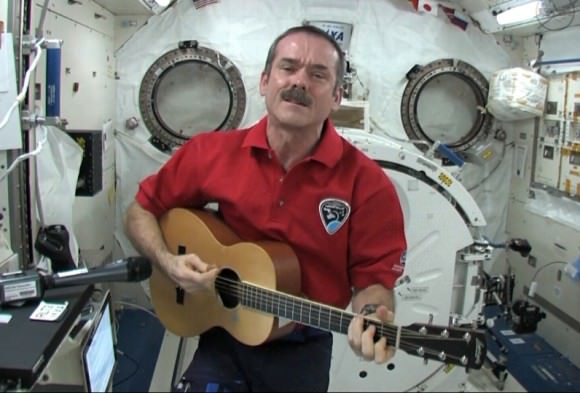
The broadcast of this event was a major media sensation, as was his rendition of David Bowie’s “Space Oddity“, which he sung shortly before departing the station in May 2013. Since retiring from the Canadian Space Agency, Hadfield has become a science communicator and advocate for space exploration. And when it comes to the future, he was quite direct in his appraisal that the we need to look to the Moon first.
According to Hadfield, one of the greatest reasons for establishing a base on the Moon has to do with its proximity and the fact that humans have made this trip before. As he stated:
“With long-haul space exploration there is a whole smorgasbord of unknowns. We know some of the threats: the unreliability of the equipment, how to provide enough food for that length of time. But there are countless others: What are the impacts of cosmic rays on the human body? What sort of spacecraft do you need to build? What are the psychological effects of having nothing in the window for months and months? And going to a place that no one has ever been before, that can’t be discounted.”
In that, he certainly has a point. At their closest – i.e. when it is at “opposition with the Sun”, which occurs approximately every two years – Mars and Earth are still very far from each othre. In fact, the latest closest-approach occurred in 2003, when the two planets were roughly 56 million km (33.9 million miles) apart. This past July, the planets were again at opposition, where they were about 57.6 million km (35.8 million miles) apart.
Using conventional methods, it would take a mission between 150 and 300 days to get from the Earth to Mars. Whereas a more fuel-efficient approach (like ion engines) would cost less but take much longer, a more rapid method like chemical rockets would could cost far more. Even with Nuclear Thermal Propulsion (NTP) or the Variable Specific Impulse Magnetoplasma Rocket (VASIMR) concept, the journey could still take 5 to 7 months.
During this time, astronauts would not only be subjected to a great deal of cosmic radiation, they would have to contend with the affects of microgravity. As studies that have been conducted aboard the ISS that have shown, long-term exposure to a microgravity environment can lead to losses in bone density, muscular atrophy, diminished eyesight, and organ damage.
Recent studies have also shown that exposure to radiation while on the surface of Mars would be quite significant. During its journey to Mars, the Curiosity rover recorded that it was subjected to average dose of 1.8 millisieverts (mSv) per day from inside its spaceship – the Mars Science Laboratory. During its first three hundred days on the surface, it was exposed to about 0.67 millisieverts (mSv) per day.
This is about half and one-fifth (respectively) of what people are exposed to during an average here on Earth. While this falls outside of NASA’s official guidelines, it is still within the guidelines of other space agencies. But to make matter worse, a new study from the University of Nevada, Las Vegas, concluded that exposure to cosmic rays could cause cell damage that would spread to other cells in the body, effectively doubling the risk of cancer.
The risks of going to the Moon, in contrast, are easy to predict. Thanks to the Apollo missions, we know that it takes between two and three days to travel from the Earth to the Moon. The Apollo 11 mission, for example, launched from the Cape Kennedy on July 16th, 1969, and arrived in lunar orbit by July 19th, 1969 – spending a total of 51 hours and 49 minutes in space. Astronauts conducting this type of mission would therefore be subject to far less radiation.
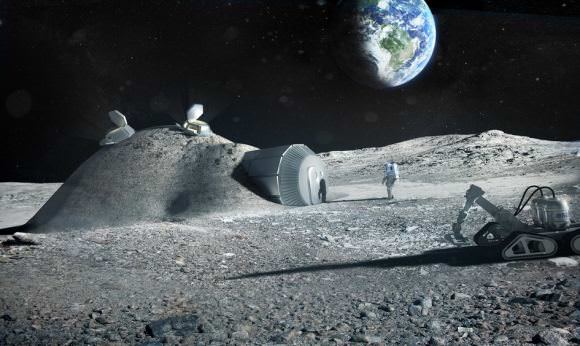
Granted, the surface of the Moon is still exposed to significant amounts of radiation since the Moon has no atmosphere to speak of. But NASA estimates that walls which are 2.5 meters in thickness (and made from lunar regolith) will provide all the necessary shielding to keep astronauts or colonists safe. Another good reason to go to the Moon first, according to Hadfield, is because expertise in off-world living is lacking.
“There are six people living on the International Space Station, and we have had people there continuously for nearly 17 years,” he said. “But the reality is we have not yet figured out how to live permanently off-planet. So I think if we follow the historically driven pattern then the moon would be first. Not just to reaffirm that we can get there, but to show that we can also live there.”
But perhaps the best reason to settle the Moon before moving onto Mars has to do with the fact that exploration has always been about taking the next step, and then the next. One cannot simply leap from one location to the next, and expect successful results. What are required is baby-steps. And in time, sufficient traction can be obtained and the process will build up speed, enabling steps that are greater and more far-reaching. Or as Hadfield put it:
“For tens of thousands of years humans have followed a pattern on Earth: imagination, to technology-enabled exploration, to settlement. It’s how the first humans got to Australia 50,000 or 60,000 years ago, and how we went from Yuri Gagarin and Alan Shepherd orbiting Earth to the first people putting footprints on the moon, to people living in orbit.
Based on this progression, one can therefore see why Hadfield and others beleive that the next logical step is to return to the Moon. And once we establish a foothold there, we can then use it to launch long-range missions to Mars, Venus, and beyond. Incremental steps that eventually add up to human beings setting foot on every planet, moon, and larger body in the Solar System.
On the subject of lunar colonization, be sure to check out our series on Building a Moon Base, by Universe Today’s own Ian O’Neill.
Further Reading: New Scientist
NASA Studies Whether to Add Crew to 1st SLS Megarocket Moon Launch in 2019
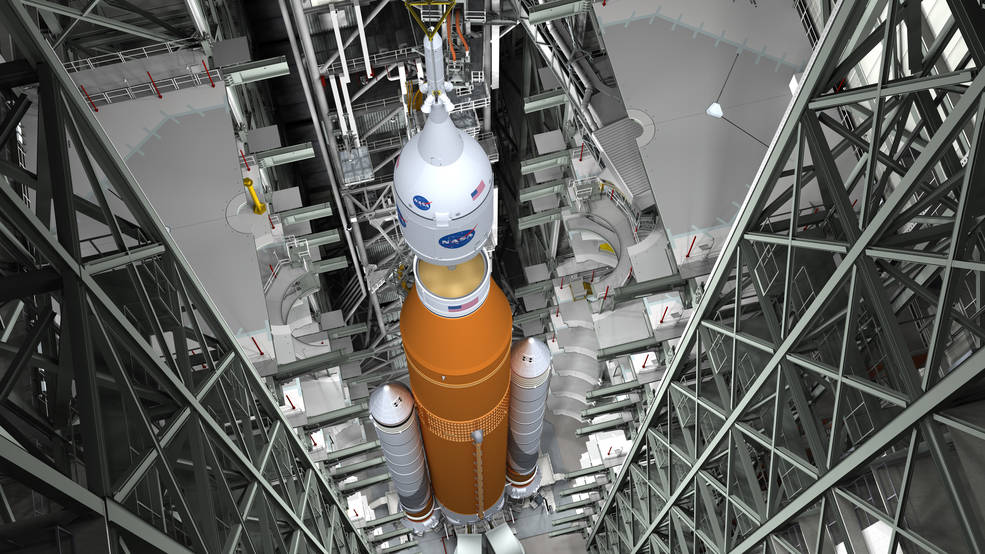

KENNEDY SPACE CENTER, FL – At the request of the new Trump Administration, NASA has initiated a month long study to determine the feasibility of converting the first integrated unmanned launch of the agency’s new Space Launch System (SLS) megarocket and Orion capsule into a crewed mission that would propel two astronauts to the Moon and back by 2019 – 50 years after the first human lunar landing.
Top NASA officials outlined the details of the study at a hastily arranged media teleconference briefing on Friday, Feb 24. It will examine the feasibility of what it would take to add a crew of 2 astronauts to significantly modified maiden SLS/Orion mission hardware and whether a launch could be accomplished technically and safely by the end of 2019.
On Feb. 15, Acting Administrator Robert Lightfoot announced that he had asked Bill Gerstenmaier, associate administrator for NASA’s Human Exploration and Operations Mission Directorate in Washington, to start detailed studies of what it would take to host astronauts inside the Orion capsule on what the agency calls Exploration Mission-1, or EM-1.
Gerstenmaier, joined by Bill Hill, deputy associate administrator for Exploration Systems Development in Washington, at the briefing said a team was quickly assembled and the study is already underway.
They expect the study to be completed in early spring, possibly by late March and it will focus on assessing the possibilities – but not making a conclusion on whether to actually implement changes to the current uncrewed EM-1 flight profile targeted for blastoff later in 2018.
“I want to stress to you this is a feasibility study. So when we get done with this we won’t come out with a hard recommendation, one way or the other,” Gerstenmaier stated.
“We’re going to talk about essentially the advantages and disadvantages of adding crew to EM-1.”
“We were given this task a week ago, appointed a team and have held one telecon.”
“Our priority is to ensure the safe and effective execution of all our planned exploration missions with the Orion spacecraft and Space Launch System rocket,” said Gerstenmaier.
“This is an assessment and not a decision as the primary mission for EM-1 remains an uncrewed flight test.”
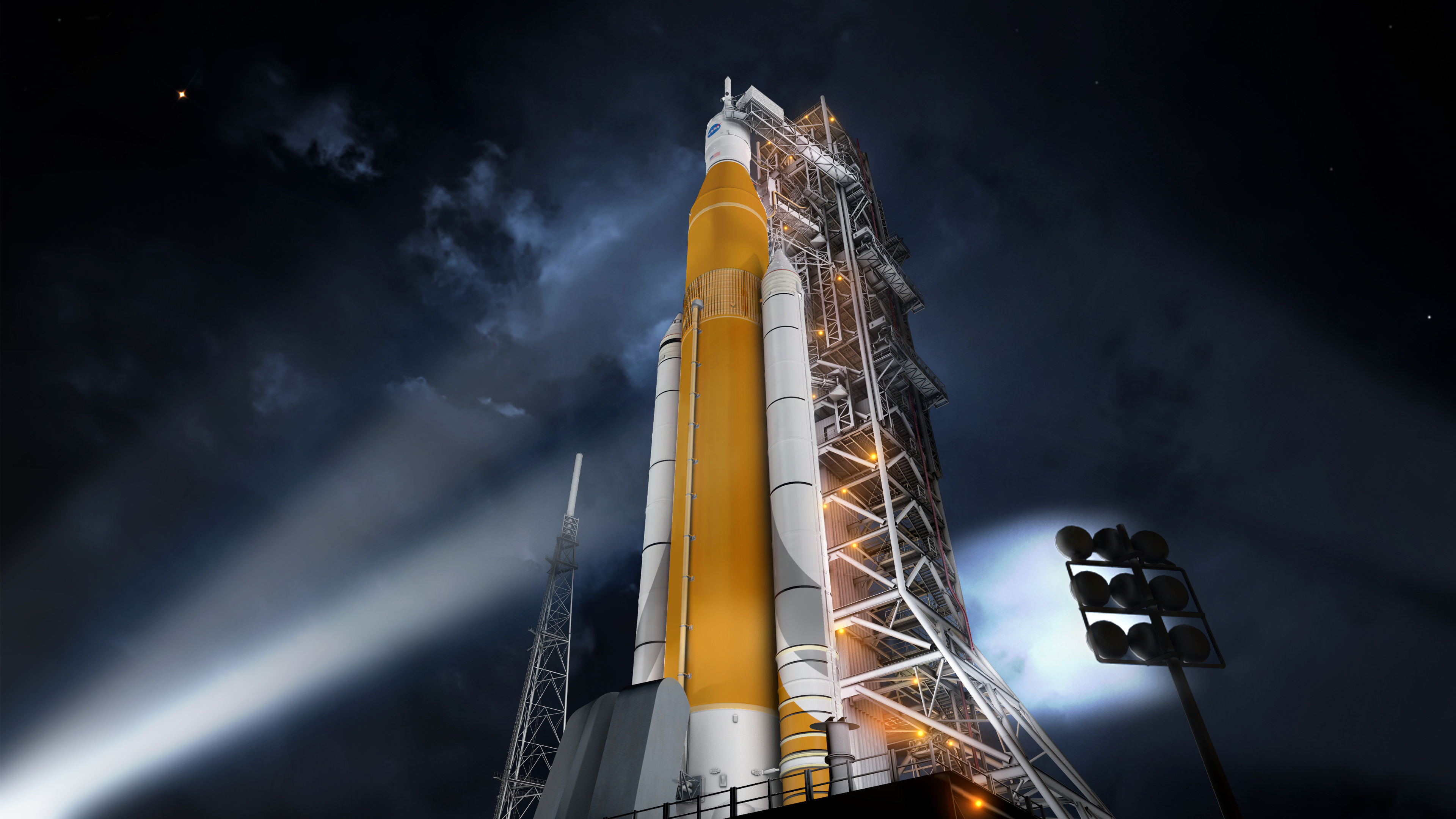
Gerstenmaier further stipulated that the study should focus on determining if a crewed EM-1 could liftoff by the end of 2019. The study team includes one astronaut.
If a change resulted in a maiden SLS/Orion launch date stretching beyond 2019 it has little value – and NASA is best to stick to the current EM-1 flight plan.
The first SLS/Orion crewed flight is slated for Exploration Mission-2 (EM-2) launching in 2021.
“I felt that if we went much beyond 2019, then we might as well fly EM-2 and actually do the plan we’re on,” Gerstenmaier said.
NASA’s current plans call for the unmanned blastoff of Orion EM-1 on the SLS-1 rocket later next year on its first test flight on a 3 week long mission to a distant lunar retrograde orbit. It is slated to occur roughly in the September to November timeframe from Launch Complex 39B at the Kennedy Space Center.
Lightfoot initially revealed the study in a speech to the Space Launch System/Orion Suppliers Conference in Washington, D.C. and an agency wide memo circulated to NASA employees on Feb. 15 – as I reported here.
The Orion EM-1 capsule is currently being manufactured at the Neil Armstrong Operations and Checkout Building at the Kennedy Space Center by prime contractor Lockheed Martin.

To launch astronauts, Orion EM-1 would require very significant upgrades since it will not have the life support systems, display panels, abort systems and more needed to safely support humans on board.
“We know there are certain systems that needed to be added to EM-1 to add crew,” Gerstenmaier elaborated. “So we have a good, crisp list of all the things we would physically have to change from a hardware standpoint.
In fact since EM-1 assembly is already well underway, some hardware already installed would have to be pulled out in order to allow access behind to add the life support hardware and other systems, Hill explained.
The EM-1 pressure shell arrived last February as I witnessed and reported here.
Thus adding crew at this latter date in the manufacturing cycle is no easy task and would absolutely require additional time and additional funding to the NASA budget – which as everyone knows is difficult in these tough fiscal times.
“Then we asked the team to take a look at what additional tests would be needed to add crew, what the additional risk would be, and then we also wanted the teams to talk about the benefits of having crew on the first flight,” Gerstenmaier explained.
“It’s going to take a significant amount of money, and money that will be required fairly quickly to implement what we need to do,” Hill stated. “So it’s a question of how we refine the funding levels and the phasing of the funding for the next three years and see where it comes out.”
Hill also stated that NASA would maintain the Interim Cryogenic Propulsion stage for the first flight, and not switch to the more advanced and powerful Exploration Upper Stage (EUS) planned for first use on EM-2.
Furthermore NASA would move up the AA-2 ascent abort test for Orion to take place before crewed EM-1 mission.
Components of the SLS-1 rocket are being manufactured at NASA’s Michoud Assembly Facility and elsewhere around the country by numerous suppliers.
Michoud is building the huge fuel liquid oxygen/liquid hydrogen SLS core stage fuel tank, derived from the Space Shuttle External Tank (ET) – as I detailed here.
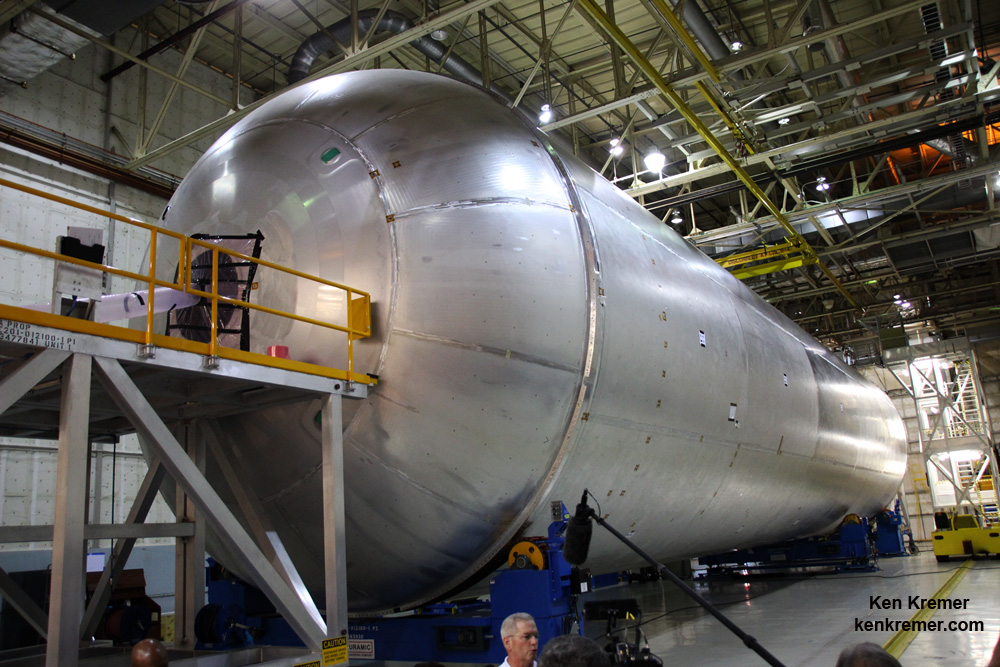
Gerstenmaier noted that Michoud did suffer some damage during the recent tornado strike which will necessitate several months worth of repairs.
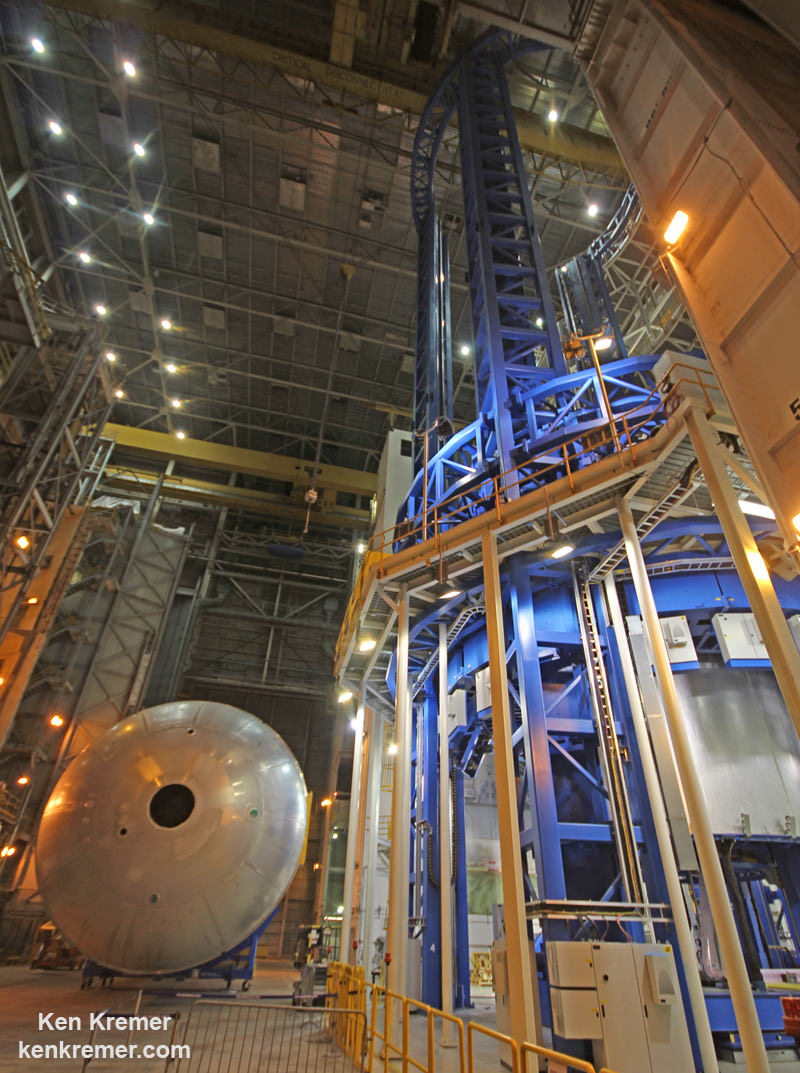
The 2018 launch of NASA’s Orion on the unpiloted EM-1 mission counts as the first joint flight of SLS and Orion, and the first flight of a human rated spacecraft to deep space since the Apollo Moon landing era ended more than 4 decades ago.
SLS is the most powerful booster the world has even seen – even more powerful than NASA’s Saturn V moon landing rocket of the 1960s and 1970s.
For SLS-1 the mammoth booster will launch in its initial 70-metric-ton (77-ton) Block 1 configuration with a liftoff thrust of 8.4 million pounds.
If NASA can pull off a 2019 EM-1 human launch it will coincide with the 50th anniversary of Apollo 11 – NASA’s first lunar landing mission manned by Neil Armstrong and Buzz Aldrin, along with Michael Collins.
If crew are added to EM-1 it would essentially adopt the mission profile currently planned for Orion EM-2.
“If the agency decides to put crew on the first flight, the mission profile for Exploration Mission-2 would likely replace it, which is an approximately eight-day mission with a multi-translunar injection with a free return trajectory,” said NASA. It would be similar to Apollo 8 and Apollo 13.
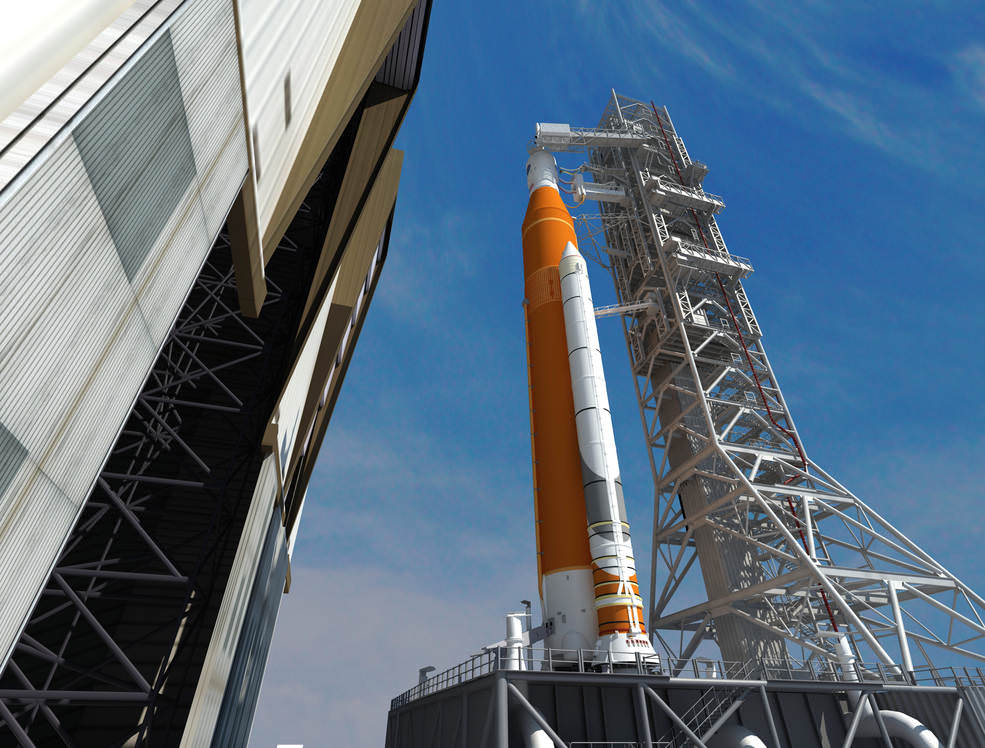
Orion is designed to send astronauts deeper into space than ever before, including missions to the Moon, asteroids and the Red Planet.
NASA is developing SLS and Orion for sending humans on a ‘Journey to Mars’ in the 2030s.
They are but the first hardware elements required to carry out such an ambitious initiative.
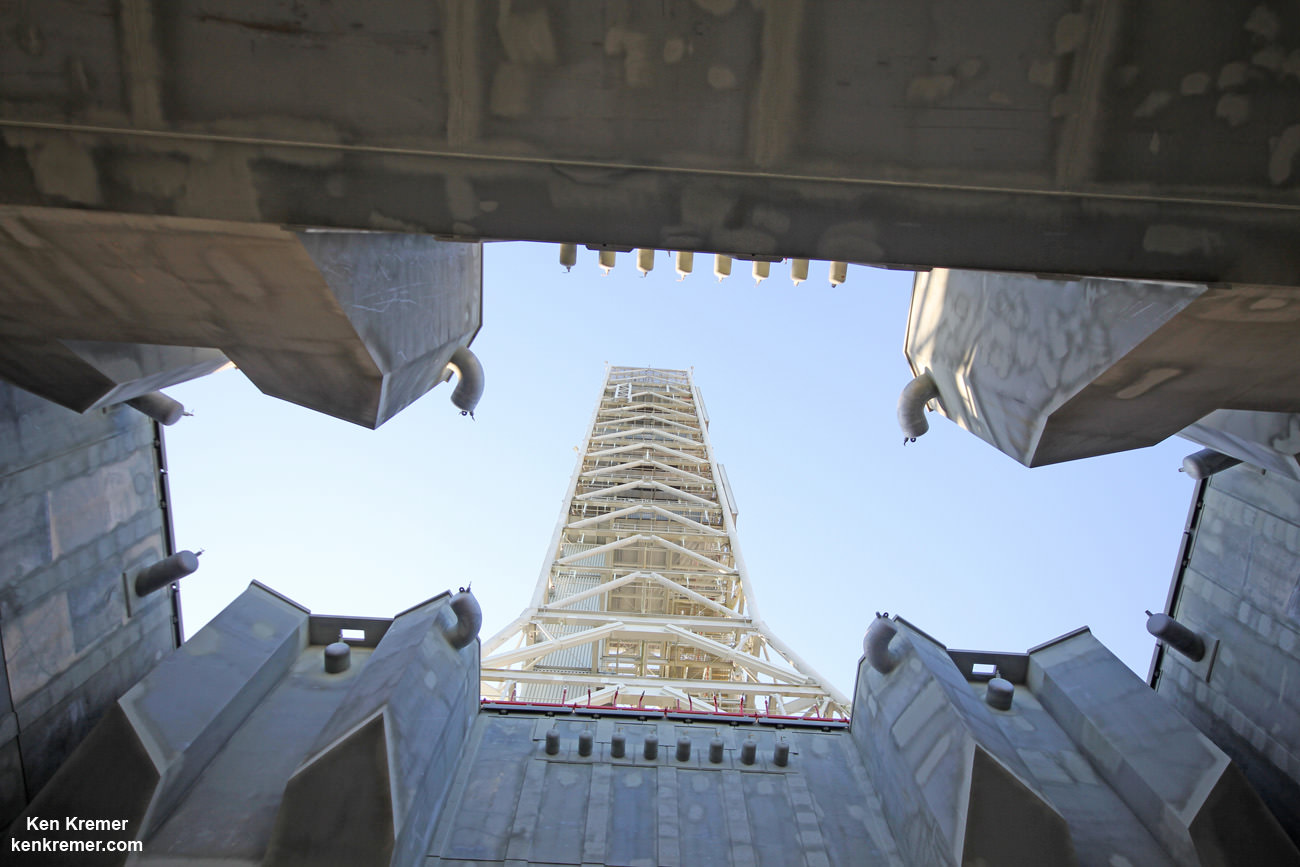
Stay tuned here for Ken’s continuing Earth and Planetary science and human spaceflight news.
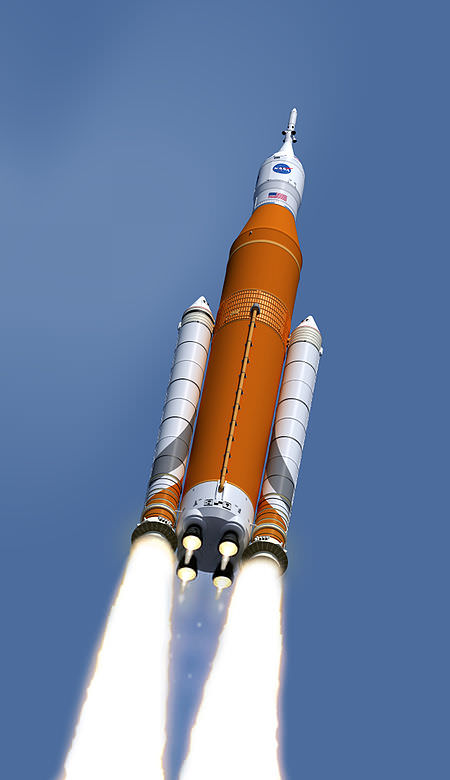
‘Insufferable’ Moonwalker Buzz Aldrin Recovering From ‘Record Setting’ Antarctic Expedition Emergency Evacuation


Buzz Aldrin – the second man to walk on the Moon – is recovering nicely today in a New Zealand hospital after an emergency medical evacuation cut short his record setting Antarctic expedition as the oldest man to reach the South Pole – which Team Buzz lightheartly noted would make him “insufferable”!
“He’s recovering well in NZ [New Zealand],” Team Buzz said in an official statement about his evacuation from the South Pole.
Apollo 11 moonwalker Buzz Aldrin, who followed Neil Armstrong in descending to the lunar surface in 1969 on America’s first Moon landing mission, had to be suddenly flown out of the Admunsen-Scott Science Station late last week per doctors orders after suffering from shortness of breath and lung congestion during his all too brief foray to the bottom of the world.
He was flown to a hospital in Christchurch, New Zealand for emergency medical treatment on Dec. 1.
Upon learning from the National Science Foundation (NSF) that Aldrin “now holds the record as the oldest person to reach the South Pole at the age of 86,” his Mission Director Christina Korp jokingly said: ‘He’ll be insufferable now.”
“Buzz Aldrin is resting in hospital in Christchurch, New Zealand. He still has some congestion in his lungs so has been advised not to take the long flight home to the States and to rest in New Zealand until it clears up,” Team Buzz said in an official statement on Dec. 3.
Buzz had been at the South Pole for only a few hours when he took ill, apparently from low oxygen levels and symptoms of altitude sickness.
“I’m extremely grateful to the National Science Foundation (NSF) for their swift response and help in evacuating me from the Admunsen-Scott Science Station to McMurdo Station and on to New Zealand. I had been having a great time with the group at White Desert’s camp before we ventured further south. I really enjoyed the time I spent talking with the Science Station’s staff too,” said Aldrin from his hospital room in a statement.
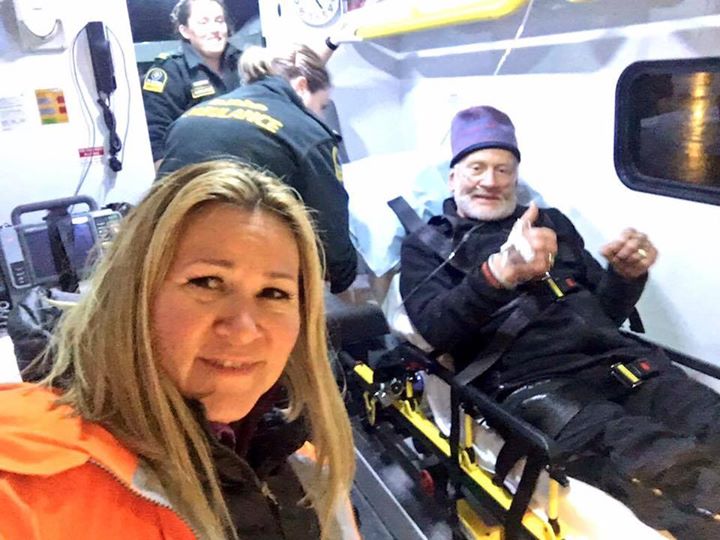
Prior to the planned Antarctic journey, his doctors had cleared him to take the long trip – which he views as “the capstone of his personal exploration achievements”.
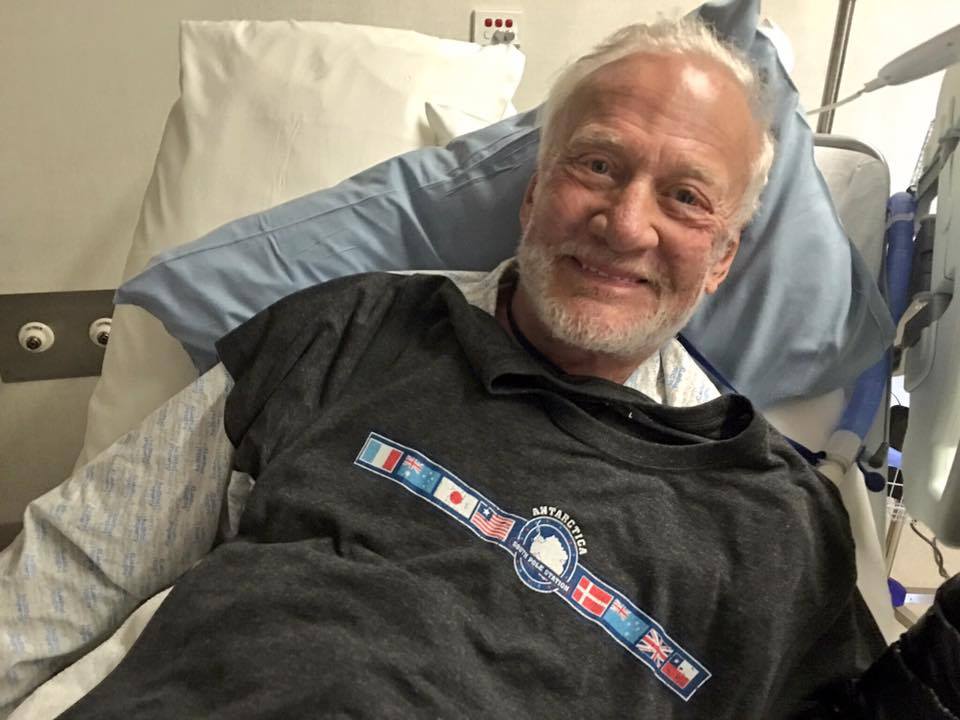
Buzz’s goal in visiting the South Pole was to see “what life could be like on Mars” – which he has been avidly advocating as the next goal for a daring human spaceflight journey to deep space.
“His primary interest in coming to Antarctica was to experience and study conditions akin to Mars that are more similar there than any other place on earth,” Team Buzz elaborated.
He had hoped to speak more to the resident scientists about their research but it was all cut short by his sudden illness.
“I started to feel a bit short of breath so the staff decided to check my vitals. After some examination they noticed congestion in my lungs and that my oxygen levels were low which indicated symptoms of altitude sickness. This prompted them to get me out on the next flight to McMurdo and once I was at sea level I began to feel much better. I didn’t get as much time to spend with the scientists as I would have liked to discuss the research they’re doing in relation to Mars. My visit was cut short and I had to leave after a couple of hours. I really enjoyed my short time in Antarctica and seeing what life could be like on Mars,” Aldrin explained.
Buzz also thanked everyone who sent him well wishes.
“Finally, thanks to everyone from around the world for their well wishes and support. I’m being very well looked after in Christchurch. I’m looking forward to getting home soon to spend Christmas with my family and to continue my quest for Cycling Pathways and a permanent settlement on Mars. You ain’t seen nothing yet!”, concluded Aldrin.
I recently met Buzz Aldrin at the Kennedy Space Center Visitor Complex in Florida, as part of the Grand Opening of the new ‘Destination Mars’ attraction.
Destination Mars is a holographic exhibit at the Kennedy Space Center visitor complex in Florida. Be sure to catch it soon because the limited time run end on New Year’s Day 2017.
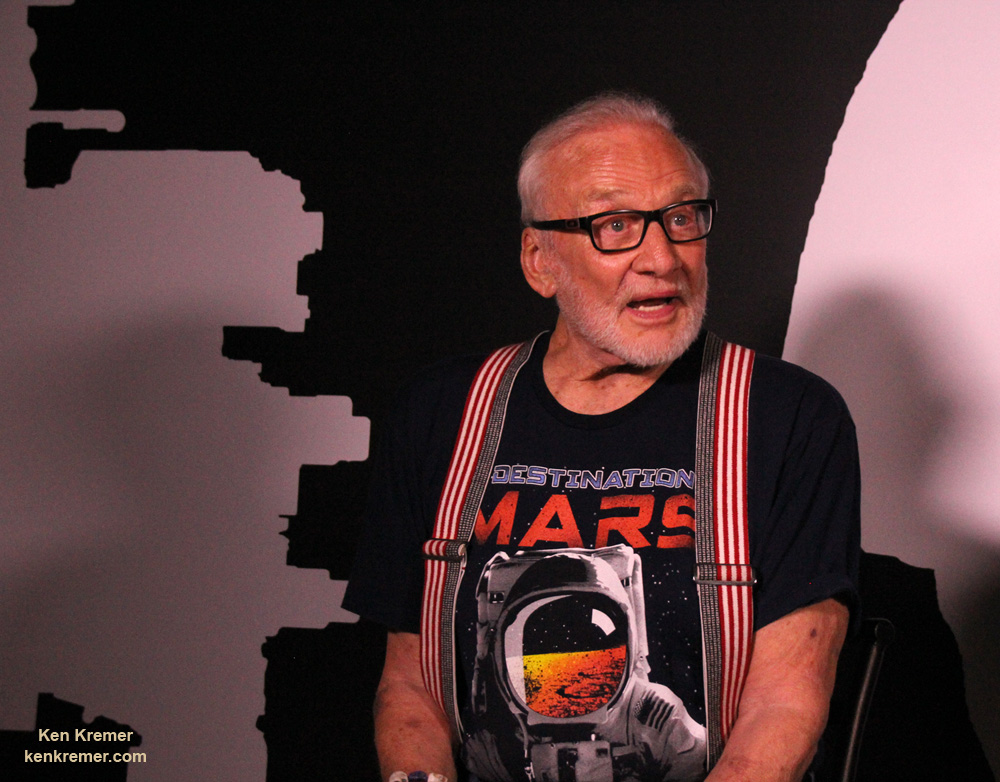
The new ‘Destination Mars’ limited engagement exhibit magically transports you to the surface of the Red Planet via Microsoft HoloLens technology.
It literally allows you to ‘Walk on Mars’ using real imagery taken by NASA’s Mars Curiosity rover and explore the alien terrain, just like real life scientists on a geology research expedition – with Buzz Aldrin as your guide.
Here’s my Q & A with moonwalker Buzz Aldrin speaking to Universe Today at Destination Mars:
Video Caption: Buzz Aldrin at ‘Destination Mars’ Grand Opening at KSCVC. Apollo 11 moonwalker Buzz Aldrin talks to Universe Today/Ken Kremer during Q&A at ‘Destination Mars’ Holographic Exhibit Grand Opening ceremony at Kennedy Space Center Visitor Complex (KSCVC) in Florida on 9/18/16. Credit: Ken Kremer/kenkremer.com
And Buzz seemed quite healthy for the very recent Grand Opening of the new ‘Heroes and Legends’ exhibit on Nov. 11 at the Kennedy Space Center Visitor Complex.
Stay tuned here for Ken’s continuing Earth and Planetary science and human spaceflight news.
………….
Learn more about ULA Delta 4 launch on Dec 7, GOES-R weather satellite, Heroes and Legends at KSCVC, OSIRIS-REx, InSight Mars lander, ULA, SpaceX and Orbital ATK missions, Juno at Jupiter, SpaceX AMOS-6 & CRS-9 rocket launch, ISS, ULA Atlas and Delta rockets, Orbital ATK Cygnus, Boeing, Space Taxis, Mars rovers, Orion, SLS, Antares, NASA missions and more at Ken’s upcoming outreach events:
Dec 5-7: “ULA Delta 4 Dec 7 launch, GOES-R weather satellite launch, OSIRIS-Rex, SpaceX and Orbital ATK missions to the ISS, Juno at Jupiter, ULA Delta 4 Heavy spy satellite, SLS, Orion, Commercial crew, Curiosity explores Mars, Pluto and more,” Kennedy Space Center Quality Inn, Titusville, FL, evenings
America’s Pioneering Astronauts Honored with new ‘Heroes and Legends’ Attraction at Kennedy Space Center
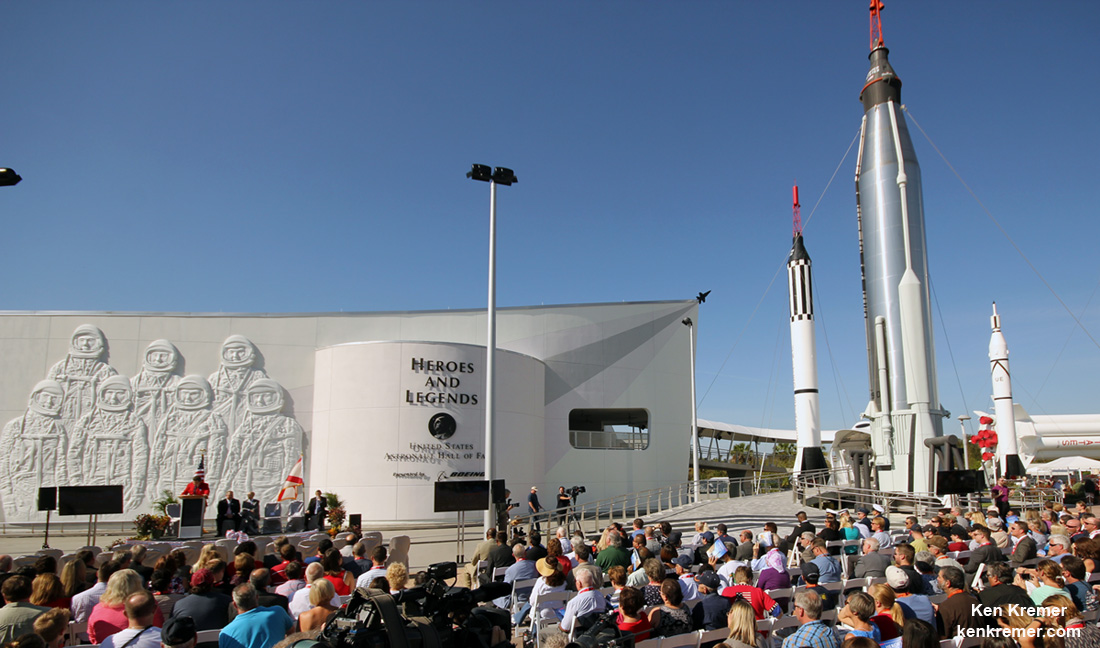

KENNEDY SPACE CENTER VISITOR COMPLEX, FL – America’s pioneering astronauts who braved the perils of the unknown and put their lives on the line at the dawn of the space age atop mighty rockets that propelled our hopes and dreams into the new frontier of outer space and culminated with NASA’s Apollo lunar landings, are being honored with the eye popping new ‘Heroes and Legends’ attraction at the Kennedy Space Center Visitor Complex (KSCVC) in Florida.
With fanfare and a fireworks display perfectly timed for Veterans Day, ‘Heroes and Legends’ opened its doors to the public on Friday, November 11, 2016, during a gala ceremony attended by more than 25 veteran and current NASA astronauts, including revered Gemini and Apollo space program astronauts Buzz Aldrin, Jim Lovell, Charlie Duke, Tom Stafford, Dave Scott, Walt Cunningham and Al Worden – and throngs of thrilled members of the general public who traveled here as eyewitnesses from all across the globe.
Aldrin, Scott, and Duke walked on the Moon during the Apollo 11, 15 and 16 missions.
Also on hand were the adult children of the late-astronauts Alan Shepard (first American in space) and Neil Armstrong (first man to walk on the Moon), as well as representatives from NASA, The Boeing Company (sponsor) and park operator Delaware North – for the engaging program hosted by Master of Ceremonies John Zarrella, CNN’s well known and now retired space correspondent.
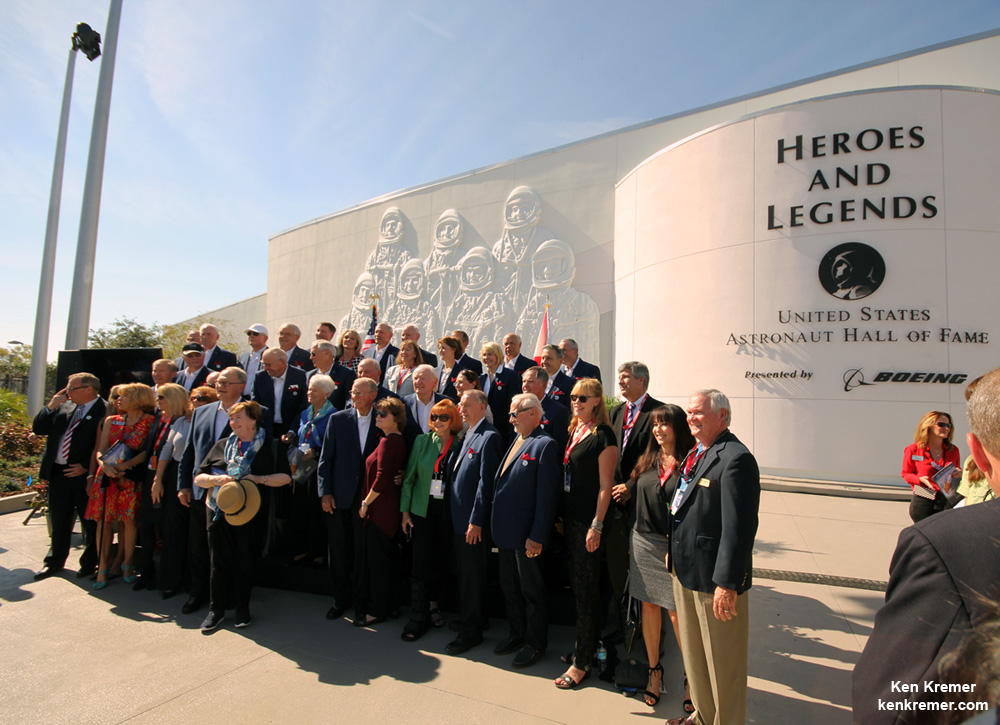
The stunning new ‘Heroes and Legends’ attraction is perfectly positioned just inside the entrance to the KSC Visitor Complex to greet visitors upon their arrival with an awe inspiring sense of what it was like to embark on the very first human journey’s into space by the pioneers who made it all possible ! And when every step along the way unveiled heretofore unknown treasures into the origin of us and our place in the Universe.
Upon entering the park visitors will immediately and surely be mesmerized by a gigantic bas relief sculpture recreating an iconic photo of America’s first astronauts – the Mercury 7 astronauts; Scott Carpenter, Gordon Cooper, John Glenn, Gus Grissom, Wally Schirra, Alan Shepard, and Deke Slayton.
“With all the drama of an actual trip to space, guests of Kennedy Space Center Visitor Complex in Florida will be greeted with a dramatic sense of arrival with the new Heroes & Legends featuring the U.S. Astronaut Hall of Fame® presented by Boeing. Positioned just inside the entrance, the attraction sets the stage for a richer park experience by providing the emotional background and context for space exploration and the legendary men and women who pioneered our journey into space,” according to a description from Delaware North Companies Parks and Resorts, which operates the KSC visitor complex.
“Designed to be the first stop upon entering Kennedy Space Center Visitor Complex, Heroes & Legends uses the early years of the space program to explore the concept of heroism, and the qualities that define the individuals who inspired their generation.”
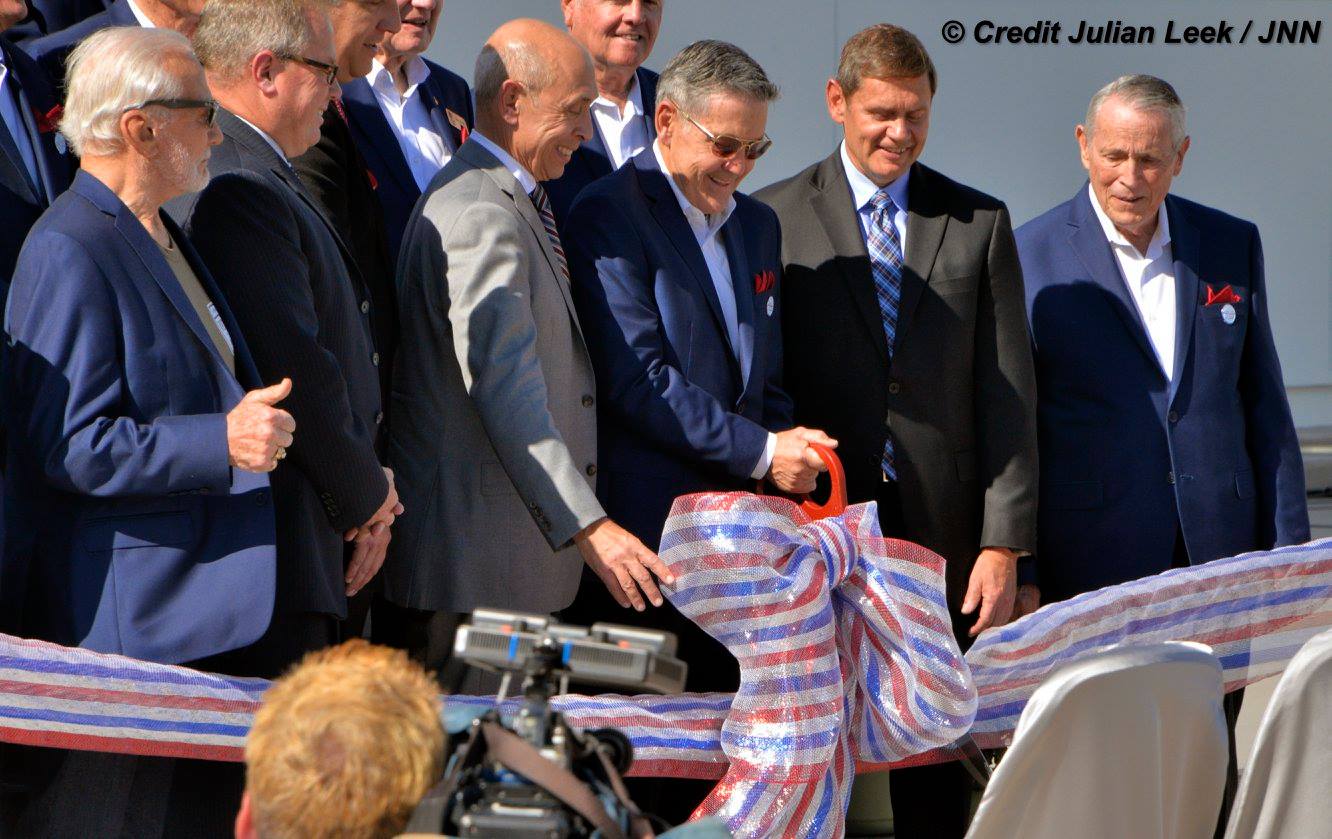
“I hope that all of you, when you get to see Heroes and Legends, you’re inspired,” said Kennedy Space Center Director Bob Cabana, a former space shuttle astronaut and member of the Astronaut Hall of Fame, during the ceremony.
“The children today can see that there is so much more they can reach for if they apply themselves and do well.”
“I think people a thousand years from now are going to be happy to see these artifacts and relics,” Apollo 15 command module pilot Al Worden told the crowd.
“We have so much on display here with a Saturn V, Space Shuttle Atlantis. People will think back and see the wonderful days we had here. And I guess in that same vein, that makes me a relic too.”
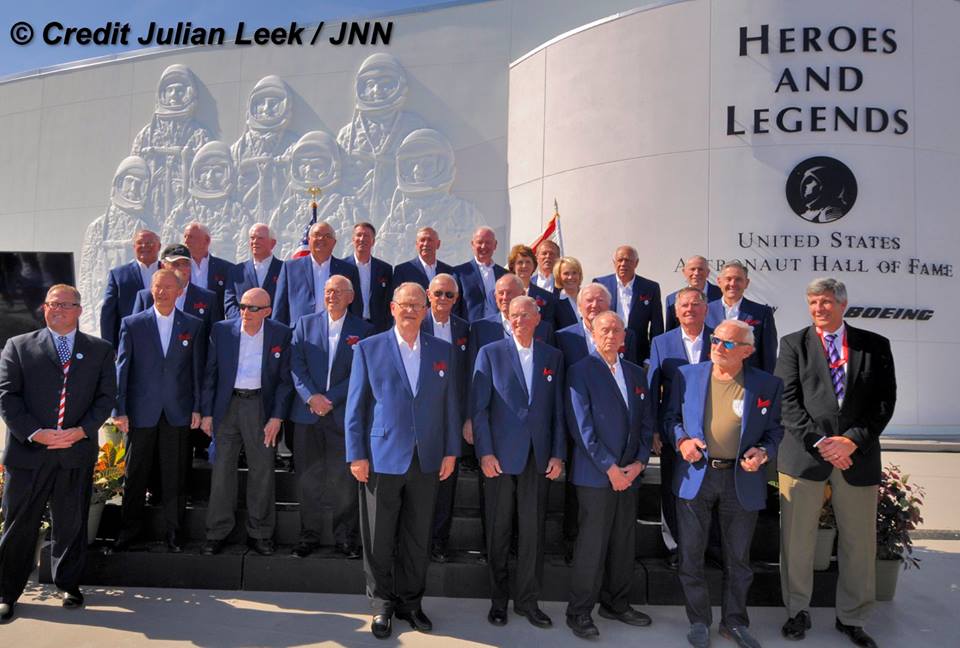
Furthermore, ‘Heroes and Legends’ is now very conveniently housed inside the new home of the U.S. Astronaut Hall of Fame (AHOF) – making for a unified space exploration experience for park visitors. AHOF previously was located at another off site park facility some seven miles outside and west of the Visitor Complex.
The bas relief measures 30 feet tall and 40 feet wide. It is made put of fiberglass and was digitally sculpted, carved by CNC machines and juts out from the side of the new into the new 37,000 square foot U.S. Astronaut Hall of Fame (AHOF) structure.
To date 93 astronauts have been inducted into the Astronaut Hall of Fame spanning the Mercury, Gemini, Apollo and Space Shuttle programs.
“I don’t consider myself a hero like say, Charles Lindbergh,” said Jim Lovell, a member of the Astronaut Hall of Fame and Apollo 13 commander, when asked by Zarrella what it feels like to be considered an American space hero. “I just did what was proper and exciting — something for my country and my family. I guess I’m just a lucky guy.”
The astronauts are also quick to say that they were supported by hundreds of thousands of dedicated people working in the space program to make Apollo happen.
“It important to remember all the dedication and hard work that it took from those of us involved in the astronaut program, but also the support we received from Kennedy and all the contractors involved in Apollo,” said Apollo 16 moonwalker Charlie Duke.
“400,000 people made it possible for 24 of us to go to the Moon.”
“So dream big, aim high!” exclaimed Duke.
“Hopefully this is an inspiration to you and your kids and grandkids.”
Construction of the facility by Falcon’s Treehouse, an Orlando-based design firm began in the fall of 2015.
“We’re focusing on a story to create what we consider a ‘launch pad’ for our visitors,” said Therrin Protze, the Delaware North chief operating officer of the Visitor Complex. “This is an opportunity to learn about the amazing attributes of our heroes behind the historical events that have shaped the way we look at space, the world and the future.
“We are grateful to NASA for allowing us to tell the NASA story to millions of guests from all over the world,” Protze said.
Visitors walk up a sweeping ramp to enter the Heroes and Legends experience.
After visitors walk through the doors, they will be immersed by two successive video presentations and finally the Hall of Fame exhibit hall.
Here’s a detailed description:
• In the stunning 360-degree discovery bay, What is a Hero?, guests will explore how society defines heroism through diverse perspectives. Each examination of heroism starts with the following questions: What is a hero; Who are the heroes of our time; and What does it take to be a hero? During the seven-minute presentation, the historic beginning of the space race is acknowledged as the impetus for America’s push to the stars in NASA’s early years and the rivalry between the United States and the Soviet Union during the Cold War.
• Through the Eyes of a Hero is a custom-built theater featuring a multi-sensory experience during which guests will vicariously join NASA’s heroes and legends on the most perilous stages of their adventures. Artistically choreographed lighting and 3D imagery will be enhanced by intense, deeply resonant sound effects to create the sensation of being “in the moment.” The seven and one-half minute show takes guests on an intimate journey with four space-age heroes to fully immerse them in the awe, excitement and dangers of the first crewed space program missions.
• The third experience, A Hero Is…, offers interactive exhibits that highlight the nine different attributes of our history making astronauts: inspired, curious, passionate, tenacious, disciplined, confident, courageous, principled and selfless. A collection of nine exhibit modules will explore each aforementioned attribute, through the actual experiences of NASA’s astronauts. Their stories are enhanced with memorabilia from the astronaut or the space program.
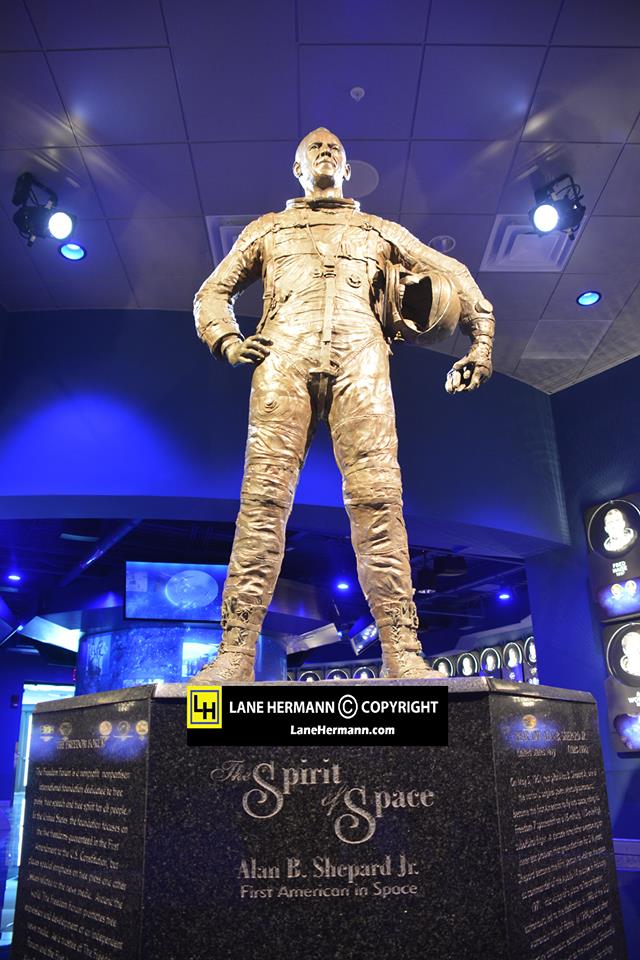
Priceless historic artifacts on display also include two flown capsules from Mercury and Gemini; the Sigma 7 Mercury spacecraft piloted by Wally Schirra during his six-orbit mission in October 1962 and the Gemini IX capsule flown by Tom Stafford and Gene Cernan for three days in June 1966.
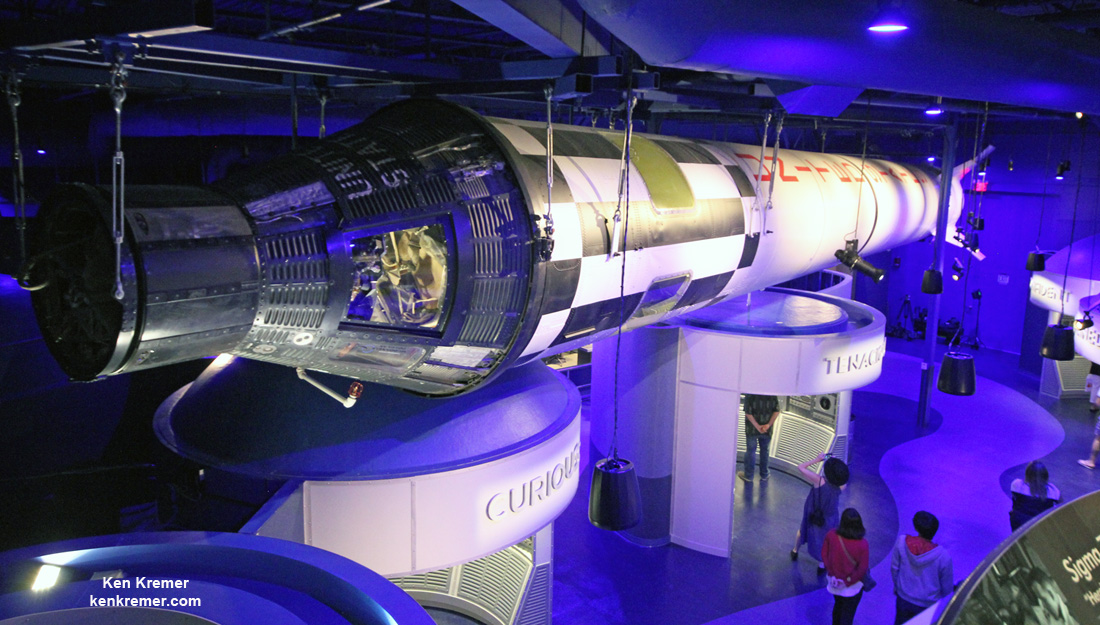
The human rated Mercury Redstone-6 (MR-6) is also on display and dramatically mated to the Schirra’s Sigma 7 Mercury capsule.
Another room houses the original consoles of the Mercury Mission Control room with the world map that was used to follow the path of John Glenn’s Mercury capsule Friendship 7 between tracking stations when he became the first American to orbit Earth in 1962.
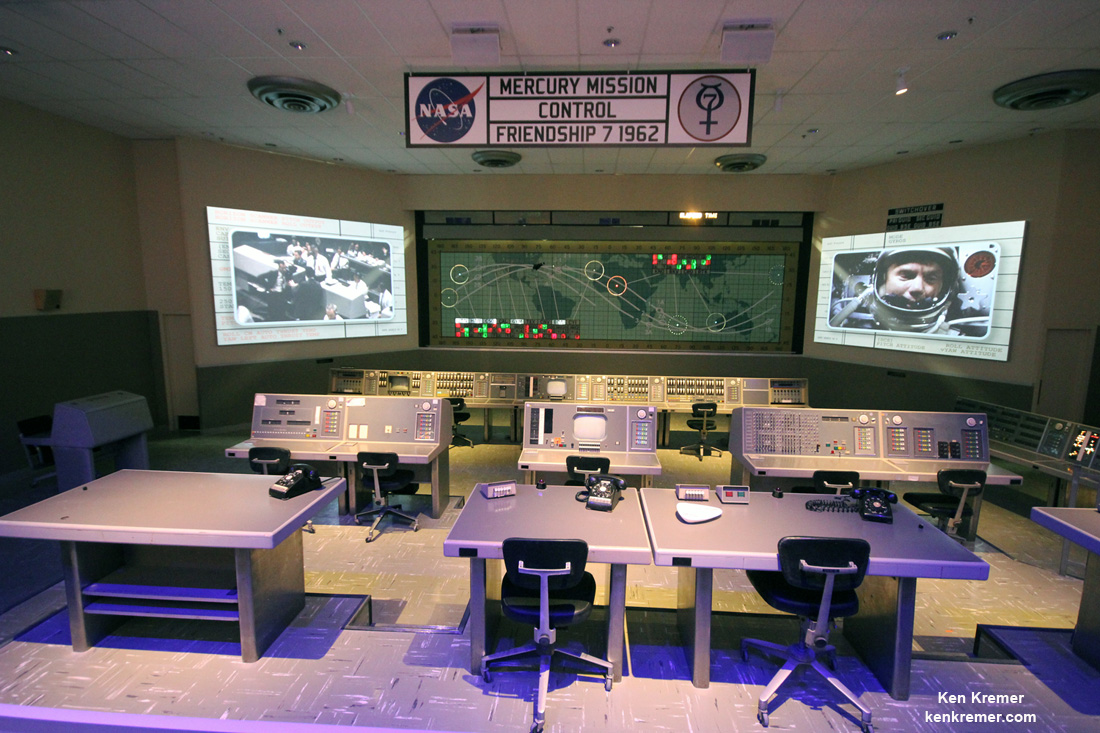
Further details about ‘Heroes and Legends, the U.S. Astronaut Hall of Fame and all other attractions are available at the Kennedy Space Center Visitor Complex website: https://www.kennedyspacecenter.com/
Stay tuned here for Ken’s continuing Earth and Planetary science and human spaceflight news.
………….
Learn more about Heroes and Legends at KSCVC, GOES-R weather satellite, OSIRIS-REx, InSight Mars lander, SpaceX missions, Juno at Jupiter, SpaceX CRS-9 rocket launch, ISS, ULA Atlas and Delta rockets, Orbital ATK Cygnus, Boeing, Space Taxis, Mars rovers, Orion, SLS, Antares, NASA missions and more at Ken’s upcoming outreach events:
Nov 17-20: “GOES-R weather satellite launch, OSIRIS-REx launch, SpaceX missions/launches to ISS on CRS-9, Juno at Jupiter, ULA Delta 4 Heavy spy satellite, SLS, Orion, Commercial crew, Curiosity explores Mars, Pluto and more,” Kennedy Space Center Quality Inn, Titusville, FL, evenings
Apollo 11 Moonwalker Buzz Aldrin Talks to Universe Today about ‘Destination Mars’


KENNEDY SPACE CENTER VISITOR COMPLEX, FL – Sending humans on a ‘Journey to Mars’ and developing strategies and hardware to accomplish the daunting task of getting ‘Humans to Mars’ is NASA’s agency wide goal and the goal of many space enthusiasts – including Apollo 11 moonwalker Buzz Aldrin.
NASA is going full speed ahead developing the SLS Heavy lift rocket and Orion crew module with a maiden uncrewed launch from the Kennedy Space Center set for late 2018 to the Moon. Crewed Mars missions would follow by the 2030s.
In the marketplace of ideas, there are other competing and corollary proposals as well from government, companies and private citizens on pathways to the Red Planet. For example SpaceX CEO Elon Musk wants to establish a colony on Mars using an Interplanetary Transport System of SpaceX developed rockets and spaceships.
Last week I had the opportunity to ask Apollo 11 Moonwalker Buzz Aldrin for his thoughts about ‘Humans to Mars’ and the role of commercial space – following the Grand Opening ceremony for the new “Destination Mars’ holographic exhibit at the Kennedy Space Center visitor complex in Florida.
Moonwalker Aldrin strongly advocated for more commercial activity in space and that “exposure to microgravity” for “many commercial products” is good, he told Universe Today.
More commercial activities in space would aid space commerce and getting humans to Mars.
“We need to do that,” Aldrin told me.
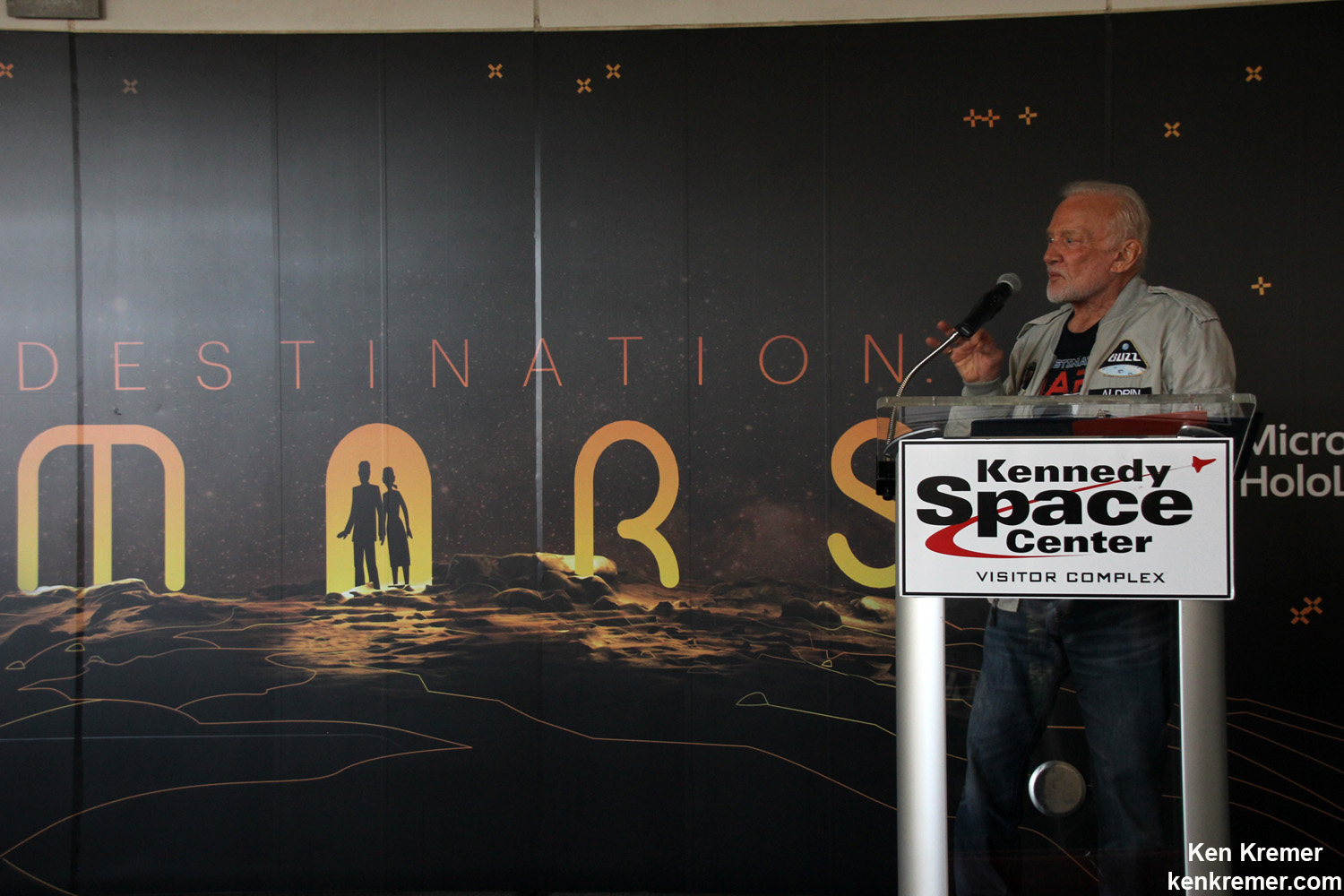
Buzz Aldrin is the second man to set foot on the Moon. He stepped onto the lunar soil a few minutes after Apollo 11 Commander Neil Armstrong, on July 20, 1969 in the Sea of Tranquility.
Aldrin also strongly supports some type of American space station capability “beyond the ISS” to foster the Mars capability.
And we need to be thinking about that follow on “US capability” right now!
“I think we need to have a US capability beyond the ISS to prepare for future activities right from the beginning,” Aldrin elaborated.
Currently the ISS partnership of the US, Russia, ESA, Japan and Canada has approved extending the operations of the International Space Station (ISS) until 2024. What comes after that is truly not known.
NASA is not planning for a follow-on space station in low Earth orbit at this time. The agency seems to prefer development of a commercial space station, perhaps with core modules from Bigelow Aerospace and/or other companies.
So that commercial space station will have to be designed, developed and launched by private companies. NASA and others would then lease space for research and other commercial activities and assorted endeavors on the commercial space station.
For example, Bigelow wants to dock their privately developed B330 habitable module at the ISS by 2020, following launch on a ULA Atlas V. And then spin it off as an independent space station when the ISS program ends – see my story.
Only China has firm plans for a national space station in the 2020’s. And the Chinese government has invited other nations to submit proposals. Russia’s ever changing space exploration plans may include a space station – but that remains to be actually funded and seen.
Regarding Mars, Aldrin has lectured widely and written books about his concept for “cycling pathways to occupy Mars,” he explained.
Watch this video of Apollo 11 moonwalker Buzz Aldrin speaking to Universe Today:
Video Caption: Buzz Aldrin at ‘Destination Mars’ Grand Opening at KSCVC. Apollo 11 moonwalker Buzz Aldrin talks to Universe Today/Ken Kremer during Q&A at ‘Destination Mars’ Holographic Exhibit Grand Opening ceremony at Kennedy Space Center Visitor Complex (KSCVC) in Florida on 9/18/16. Credit: Ken Kremer/kenkremer.com
Here is a transcript:
Universe Today/Ken Kremer: Can you talk about the role of commercial space [in getting humans to Mars]. Elon Musk wants to try and send people to Mars, maybe even before NASA. What do you think?
Buzz Aldrin: “Well, being a transportation guy in space for humans – well commercial, what that brings to mind is tourism plus space travel.
And there are many many more things commercial that are done with products that can be fine tuned by exposure to microgravity. And we need to do that.”
“I think we need to have a US capability beyond the ISS to prepare for future activities right from the beginning.”
“And that’s why what has sort of fallen into place is the name for my plan for the future – which is ‘cycling pathways to occupy Mars.’”
“A cycler in low Earth orbit, one in lunar orbit, and one to take people to Mars.”
“And they are utilized in evolutionary fashion.”
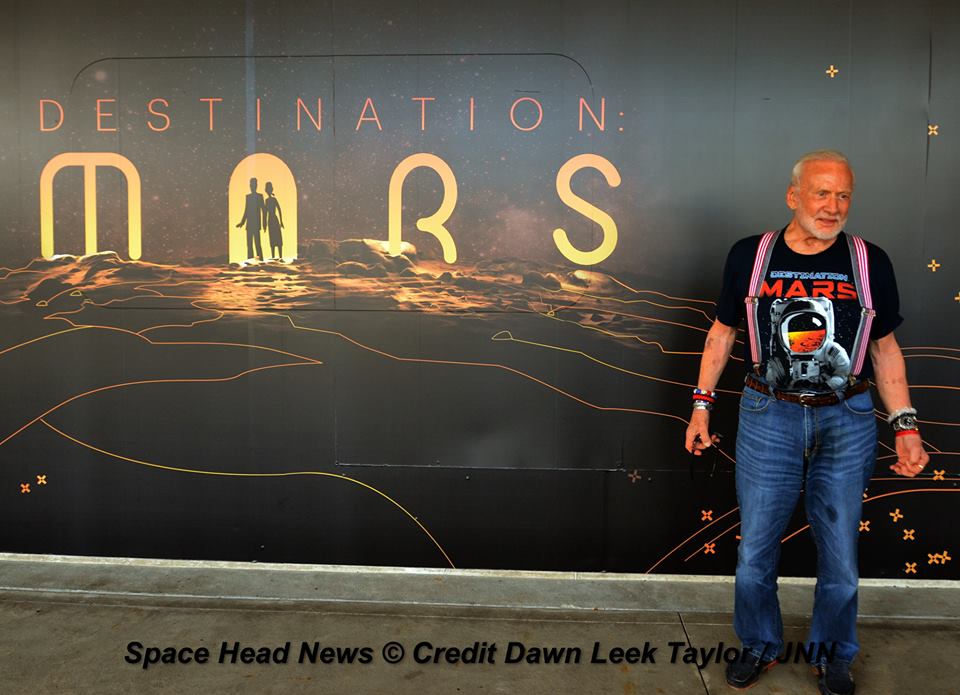
Meanwhile, be sure to visit the absolutely spectacular “Destination Mars” holographic exhibit before it closes on New Year’s Day 2017 – because it is only showing at KSCVC.
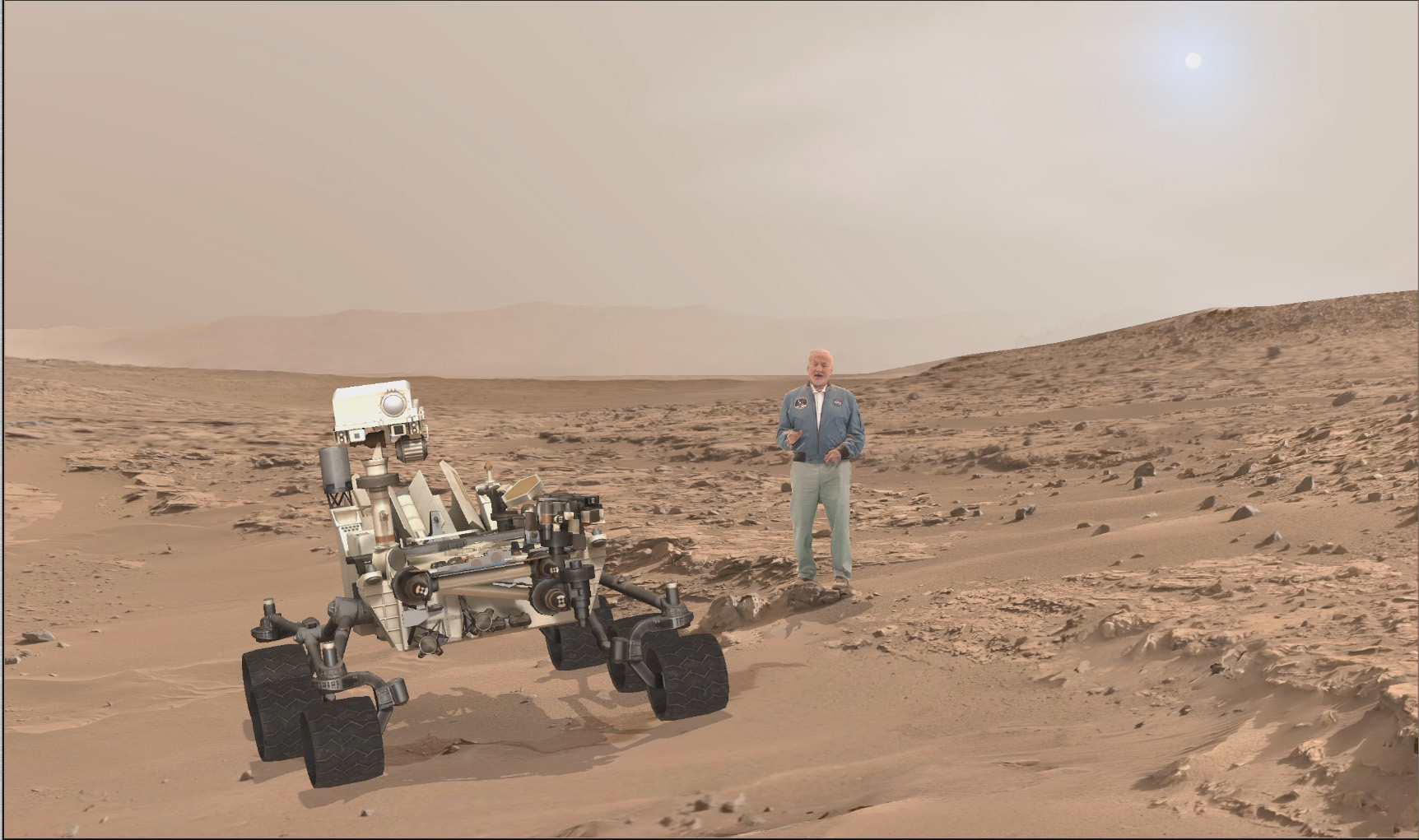
You can get more information or book a visit to Kennedy Space Center Visitor Complex, by clicking on the website link:
https://www.kennedyspacecenter.com/things-to-do/destination-mars.aspx
Stay tuned here for Ken’s continuing Earth and planetary science and human spaceflight news.
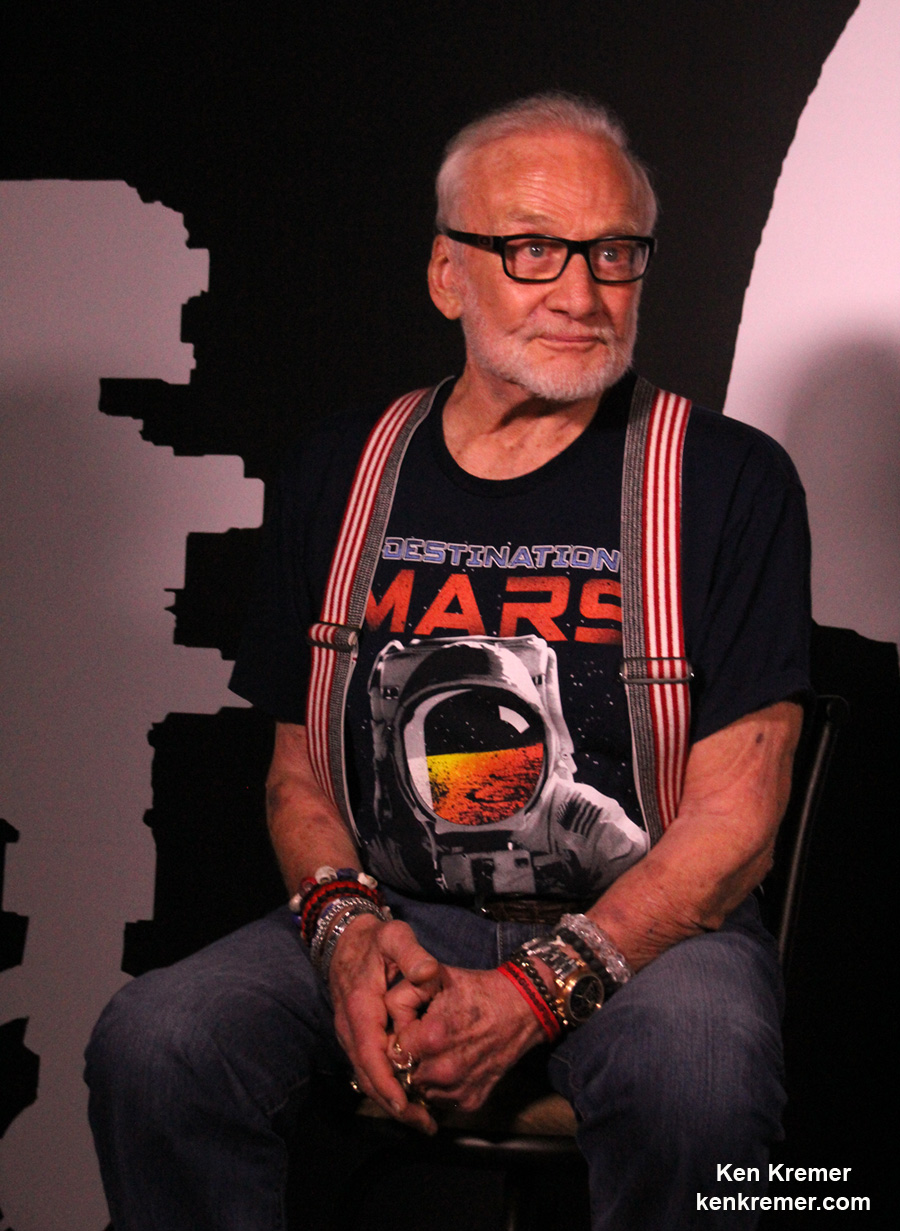
Apollo 11 Artifact Caught In Legal Dispute
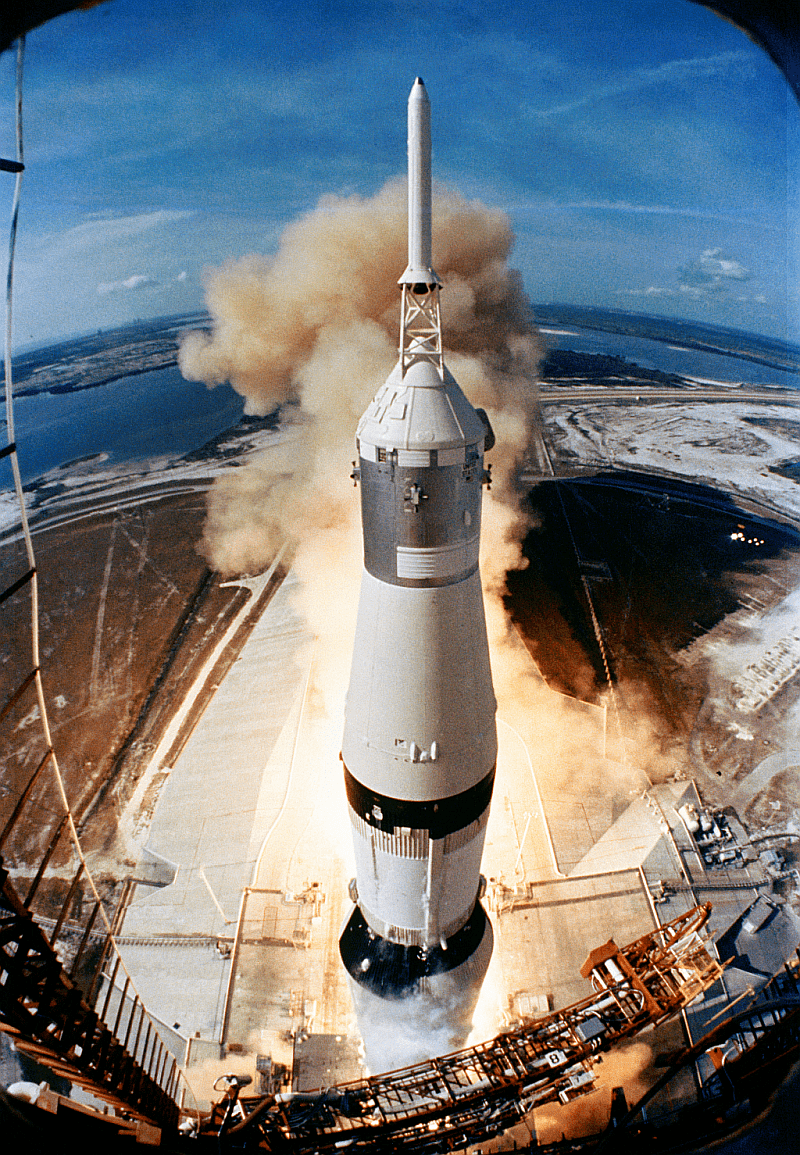
A bag that travelled to the Moon and back is at the heart of a legal dispute involving NASA and a woman named Nancy Carlson. Carlson currently owns the bag and obtained it legally. But NASA is in possession of the bag, and the US Attorney’s Office wants the courts to quash Carlson’s purchase of the bag, so they can retain ownership of this important piece of space memorabilia.
The lawsuit over the lunar sample bags was first reported by Roxana Hegeman of the Associated Press, and covered by Robert Pearlman at collectspace.com.
The story of the Apollo 11 bag is bit of a tangled web. To understand it, we have to look at a third figure, Max Ary. Ary was the founder and long-time director of the Kansas Cosmosphere and Space Center. In 2005, Ary was convicted for stealing and selling museum artifacts.
Hundreds of space artifacts and memorabilia, some on loan from NASA, had gone missing. In 2003, the Apollo 11 bag was found in a box in Ary’s garage during the execution of a search warrant as part of the case against him. However, the bag was misidentified due to a spreadsheet error, and sold to Carlson at a government auction for $995.
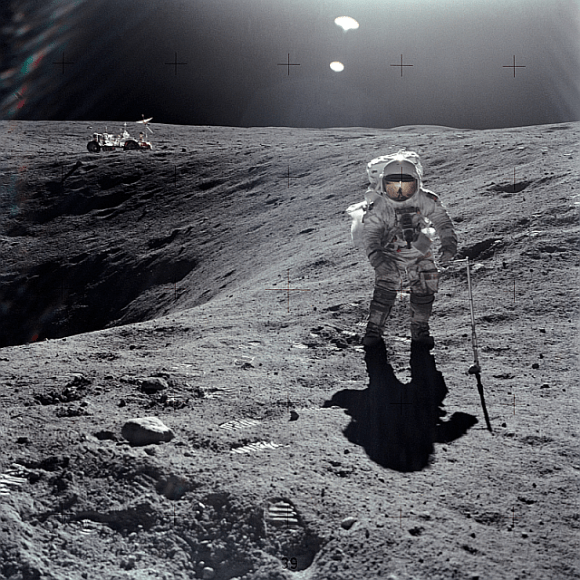
NASA only found out about the Apollo 11 bag after Carlson purchased it. Carlson sent it to the Johnson Space Center in Houston to be authenticated. Once NASA realized what the bag was, they set the legal process in motion to set aside the forfeiture and sale. The US Attorney’s office argued that NASA was not properly notified of the bag’s forfeiture because it was not labelled properly.
NASA’s attorney’s wrote “NASA was denied the opportunity to assert its interest in the lunar bag. Had NASA been given notice of the forfeiture action and/or had all the facts about the lunar bag been known, the lunar [sample return] bag would never have gone to a government auction.”
The attorneys added that “The true identity and ownership of the lunar bag are now known. The failure to give proper notice to NASA can be corrected by setting aside the forfeiture and rescinding its sale,” they stated. “These are unusual circumstances that warrant the particular relief sought.”
If this seems like quite a bit of fuss over a bag, remember that this bag travelled to the Moon and back, making it very rare. Apollo 11 astronauts used it to collect the first samples from the Moon, and dust fragments from the Moon are embedded in its fabric. It’s a very valuable historic and scientific artifact. The government said in a statement that the bag is “a rare artifact, if not a national treasure.”
Carlson, who obtained the bag legally at an auction, is an attorney and is now suing NASA for “unwarranted seizure of my personal property… without any legal provocation.” This after she voluntarily submitted the bag to NASA for authentication, and after NASA offered to reimburse her purchase price and an additional $1,000 dollars “in appreciation for your assistance in returning the bag” and “to offset any inconvenience you may have suffered.”
There’s no question that artifacts like these belong in NASA’s public collection, and on display in a museum. But Carlson obtained the bag through a legal auction. Maybe, as the bag’s purchaser, Carlson is hoping that NASA will tender a larger offer for return of the bag, and she can make some profit. That’s pure speculation of course. Perhaps she’s just very keen on owning this piece of history.
As for Max Ary, the man who set all this in motion years ago, he is now out of prison and maintains his innocence. Ary collected other space artifacts and memorabilia and sold them from his home, and he claims that it was just a mix up. He was convicted though, and he served just over 2 years of his 3 year prison sentence. He was also ordered to pay $132,000 in restitution.
Sources: Collectspace.com, Roxana Hegeman (AP)
Apollo 11 Landing 47 Years Ago; See it Through New Eyes
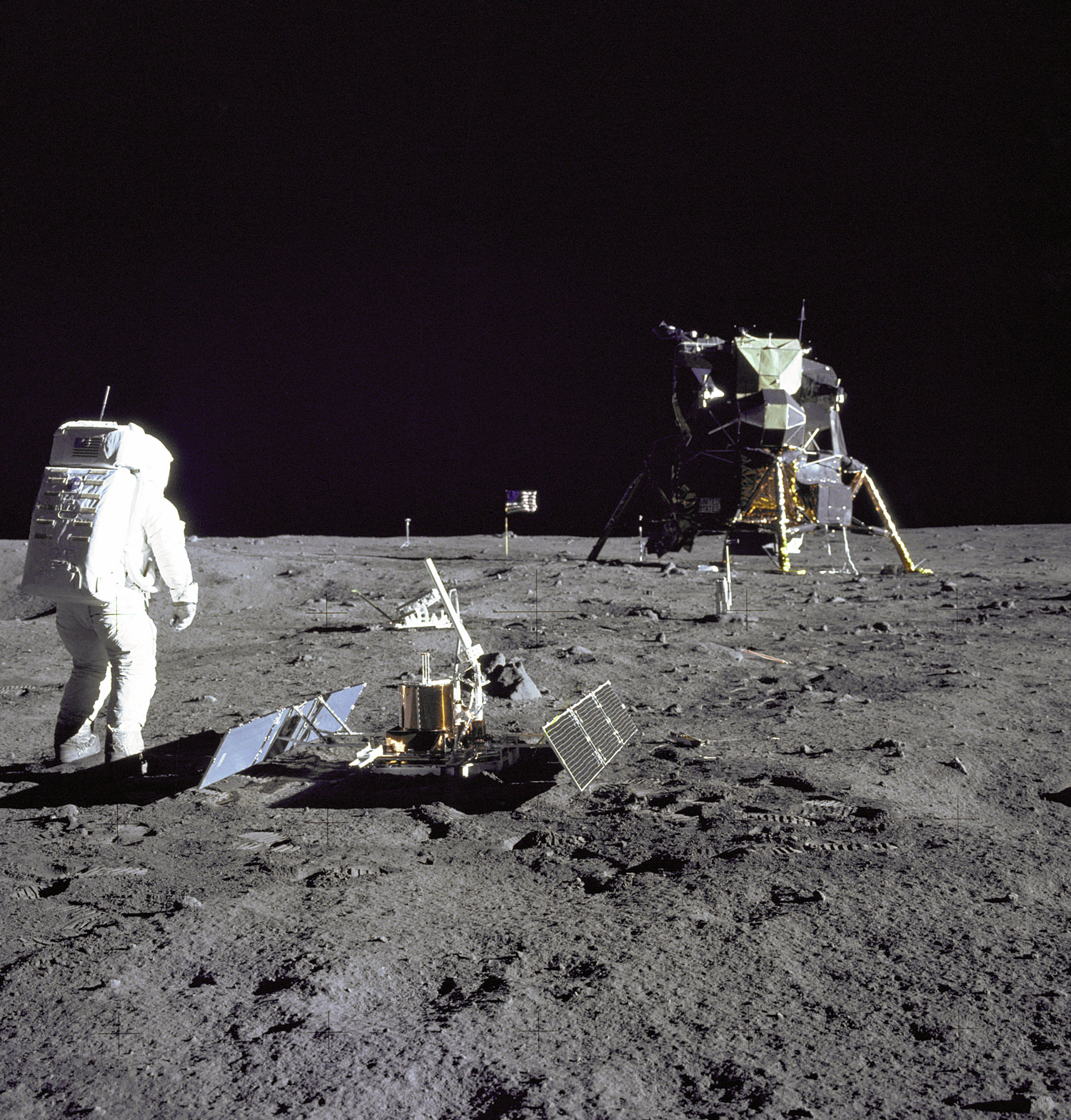
Looking for a way to commemorate the 47th anniversary of the Apollo 11 mission landing on the Moon? Here are a few different ways look back on this historic event and take advantage of advances in technology or new data.
Below is a video that uses data from the Lunar Reconnaissance Orbiter and its amazing suite of cameras, offering a side-by-side view of Apollo 11’s descent, comparing footage originally shot from the Eagle lunar module’s window with views created from reconstructed LRO imagery. This is a fun way to re-live the landing — 1202 alarms and all — while seeing high definition views of the lunar surface.
The National Air and Space Museum in Washington, DC has a special way to mark the Apollo 11 anniversary. They have posted online high-resolution 3-D scans of the command module Columbia, the spacecraft that carried astronauts Neil Armstrong, Buzz Aldrin and Michael Collins to the Moon. This very detailed model allows you to explore the entire spacecraft’s interior, which, if you’ve ever visited the Air & Space museum and seen Columbia in person, you probably know is a tremendous ‘upgrade,’ since you can only see a portion of the interior through couple of small hatches and windows. The Smithsonian is also making the data files of the model available for download so it can be 3-D printed or viewed with virtual-reality goggles. Find all the details here.
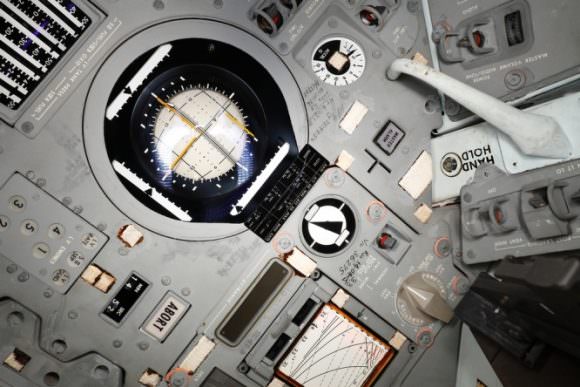
Here’s a remastered version of the original mission video as aired in July 1969 depicting the Apollo 11 astronauts conducting several tasks during the moonwalk (EVA) operations on the surface of the moon, which lasted approximately 2.5 hours.
If you’re pressed for time, here’s a quick look at the entire Apollo 11 mission, all in just 100 seconds from Spacecraft Films:
Here’s a very cool detailed look at the Apollo 11 launch in ultra-slow motion, with narration:
Enjoy, and happy anniversary!

